Top Places to Visit and Things to Do in Tokyo
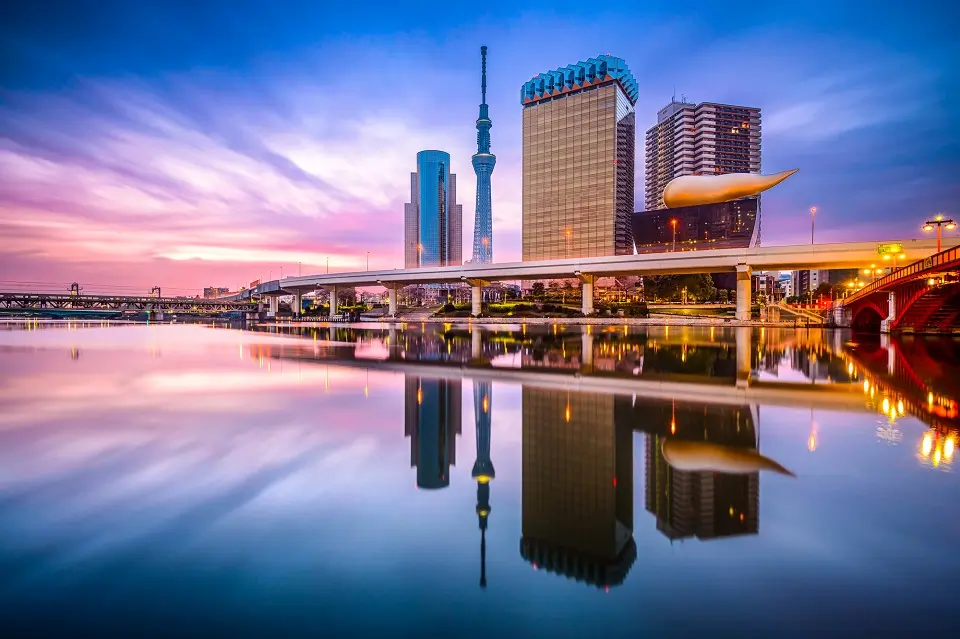
Initially, we named this guide “Tourist Attractions in Tokyo,” but we realized the title did not do justice. Tokyo offers so many places to visit and things to do that not just tourists but most long-time residents might not be able to experience them all.
So, whether you plan to visit Tokyo as a tourist, for business, or to live there, we hope this guide to Tokyo’s tourist spots and attractions will be useful not only for guiding you to the top places to see and things to do in Tokyo but also in scheduling your Tokyo trip.
As insiders who have lived in Tokyo for a long time, we will discuss places and activities tourists should not miss while exploring the city. We have made serious efforts to highlight places that may not be well-represented in traditional tourist guides while not neglecting the famous places in Tokyo that tourists should not miss.
Tokyo, a City with Things to Do for Every Age and Taste
Tokyo is the world’s largest metropolis by population. It has a long and rich history and offers a wide variety of places and attractions for tourists to explore.
Almost everyone knows about famous attractions like Tokyo Disneyland, Tokyo Tower, Tokyo Skytree, etc. Tokyo has many other interesting places to experience culture, outdoor adventures, dining, and shopping.
Many people think of Tokyo as a concrete jungle, and they are not wrong. However, if you explore deeper, you will find that Tokyo is a metropolis where every age group and every interest can find something enjoyable to do. From places like Bunkyo Ward with a traditional atmosphere to ultramodern areas like Ginza and Roppongi, Tokyo is a modern city with amazing contrasts that offer a glimpse into the traditions.
So, let’s explore the places in Tokyo and the various activities available to people with diverse interests.
(Note: You may also like to read about the Kids-friendly places in Tokyo and Japan.)
Akihabara: Electronics to Otaku Culture
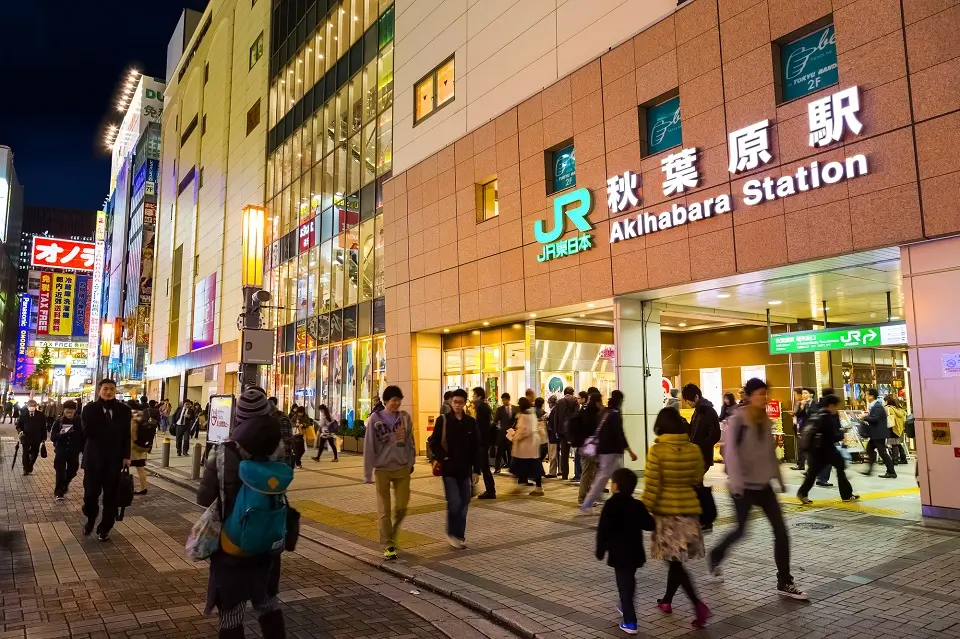
If you visit Tokyo, saying “No” to visiting Akihabara is certainly a BIG No!!!
Akihabara, or “Akiba” in short, can also be referred to as the electronics capital of not just Tokyo but also Japan.
Unsurprisingly, the attraction of electronics, especially consumer electronics, among the young generation made Akihabara a hotspot for hobbyists, including video gamers and tech-savvy individuals who often had overlapping interests in anime and manga. This series of interconnected developments made Akihabara expand into a big center of otaku culture, with many stores and cafés related to Japanese pop culture.
Moreover, as happens with any place that attracts a huge number of people, Akihabara has become more than electronics, anime, and manga; it’s a place worth visiting for its atmosphere of refreshing energy.
Let’s see how to reach Akihabara and what you can do there.
Train Access to Akihabara
Akihabara is centrally located in the Chiyoda ward of Tokyo, two stations away from Tokyo on the JR Yamanote or JR Keihin-Tohoku Lines.
The following train connectivity makes Akihabara very conveniently accessible from all important locations in Tokyo:
- Tokyo Metro: Hibiya Line
- JR East: Yamanote Line, Keihin-Tohoku Line, and Chūō-Sōbu Line
- Metropolitan Intercity Railway Company: Tsukuba Express
What All You Can Do in Akihabara
Electronics Shops:
The foundation of Akihabara as an electronics district dates back to the 1930s. During that time, Akihabara became a hub for white goods and household electronics. However, it was only during the post-second World War that Akaihabara earned its reputation as the “Electric Town.”
You may ask why it’s not called an Electronics town! The first reason is that electric and electronic goods go hand-in-hand, and Akihabara sells both. The second reason is that the Japanese language has no translation for Electronics.
Please note that, apart from the latest electronic items, Akihabara is the place where you can find second-hand items or replacement electronic parts that you have not been able to find anywhere else.
The largest Electronics Stores in Akihabara
Apart from being the home of Yodobashi Camera’s flagship store, the largest electronics retailer in Japan, Akihabara has many other large electronics stores. Some of those are as follows:
- Yamada Denki LABI Akihabara
- BIC Camera, Akihabara
- LAOX Akihabara Main Store (Japan’s largest duty-free shop)
- EDION Akiba
- Softmap for used computer parts
- Camera Kitamura for used cameras
Apart from the above big stores, there are countless mid-sized stores and small shops where you can find what you wish for in electronics and electrical items.
Anime and Manga Shops:
As mentioned above, Akihabara is also the hub for Otaku culture. So, if you are an anime or manga fan or love gaming, you can find many stores that sell everything related to anime and manga. Some of such stores are Animate, Mandarake, and Comic Toranoana.
Game Centers:
Amusement arcades and pachinko are significant parts of Japanese pop culture, and Akihabara has some of the best. Venues like Badai Namco Akihabara and Taito Station are multi-floor buildings with video games, claw machines, purikura (photo sticker booths), and more. Apart from these, Akihabara is also home to many pachinkos.
Maid Cafés:
As soon as you come out of the Akihabara station, you will find cute girls in crazy-looking dresses inviting you to the maid cafés. This scene continues while you are walking on the streets of Akihabara. To many foreigners who recently landed in Tokyo for the first time, these girls represent a cultural shock, but wait for more surprises until you visit a maid café they wish you to visit!
Akihabara is the birthplace of the “maid café” culture. In these cafés, servers dress up in maid costumes and treat patrons in a role-play scenario. You can enjoy the informal atmosphere of these cafes by watching the servers’ performances, chatting with them, and playing games with them. It’s a unique experience that emerged from otaku culture.
Themed Cafés and Stores:
Akihabara also has many other themed cafés and stores. Some of such famous themed cafes are as follows:
- Square Enix Café: A café for lovers of video games, such as Final Fantasy and Dragon Quest.
- Train-Izakaya LittleTGV: As the name suggests, Train-Izakaya LittleTGV is a railway-themed café.
- Shinobazu Ninja Café Akihabara Manseijo: A Ninja themed café.
- Seiyu no Tamago: A themed café for anime and video game enthusiasts to interact with rookie voice actors.
Gachapon Kaikan:
Gachapon, or gacha-gacha, is a term for a capsule toy dispensed from vending machines. These toys are especially favorites among children. You can find these vending machines all over Japan in supermarkets and other places.
However, in Akihabara, you can find huge stores dedicated to Gachapon. For example, Gachapon Kaikan in Akihabara has hundreds of Gachapon vending machines, each dispensing a unique set of capsule toys.
Map of Above Akihabara Places to Visit
Yanaka (谷中): The Charm of Old Tokyo
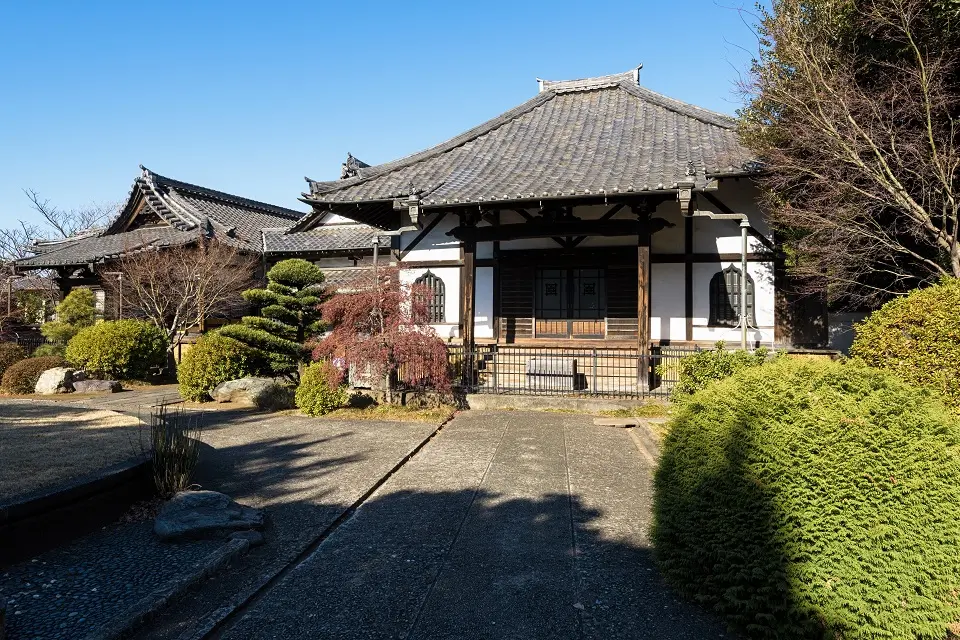
The Yanaka district in Tokyo’s Taito ward is famous for its old Tokyo atmosphere, with its quiet streets, traditional buildings, and many temples.
The name Yananka (谷中) consists of two Kanji 谷 (valley) and 中 (Inside), which means inside a valley. You will certainly enjoy the experience of being outside Tokyo in this most traditional part of Tokyo while being in modern and bustling Tokyo.
Train Access to Yanaka
Yanaka is an 8-minute walk from Nippori station in the Arakawa ward (Arakawa-ku) and 6 minutes from Sendagi station in the Bunkyo ward of Tokyo. Following are the trains which you can take to reach Yanaka:
Access to Nippori Station:
- JR East: Yamanote Line, Keihin-Tohoku Line, and Joban Line
- Keisei Electric Railway: Keisei Main Line
- Toei: Nippori-Toneri Liner
Access to Sendagi Station:
- Tokyo Metro: Chiyoda Line
Things to Do in Yanaka
Following are the places and activities you can enjoy in the Yanaka district of Tokyo:
Yanaka Cemetery:
Yanaka Cemetery is one of Tokyo’s largest and most famous cemeteries. It offers a peaceful, relaxing atmosphere to enjoy a break from the fast-paced life of Tokyo. Though this place is charming throughout the year, you will especially enjoy its beauty if you visit it during the Sakura (cherry blossom) season.
Yanaka Ginza Shopping Street:
Unlike Ginza-Dori Street in Ginza, which is famous for its glamorous upscale modern shopping and dining experiences, the Yanaka Ginza shopping street holds the old-town charm. It’s a great place to buy traditional goods and enjoy street food like grilled unagi (eel) skewers or sweet potato chips.
Local Temples and Shrines:
The Yanaka area was built as a temple town in the Edo period. Therefore, this traditional and historical district has many temples and shrines. Some of the famous temples that are worth visiting in Yanaka are Tennōji, Jōmyōin, Rinkōji, Enjuji Nikkadō, and Daienji.
Art Galleries in Yanaka:
Historically, Yanaka, with its temples and shrines, was also home to many famous artists and writers, including Fumio Asakura. The area still keeps its artistic side alive with many small art galleries and workshops.
The Asakura Museum of Sculpture and SCAI The Bathhouse are two places to appreciate the Yanaka district’s connection with art.
The Asakura Museum of Sculpture was the home of the artist Fumio Asakura, who displayed his Western-style sculptures. SCAI The Bathhouse was an earlier bathhouse converted into an art gallery.
However, there are several other art galleries in Yanaka that you will find interesting. Some of these galleries are Space Oguraya, Gallery Necomachi, Gallery Okubo, and Edokoro Allan West.
Kayaba Coffee House:
Kayaba Coffee House is located in a building built in 1916, but it was established in 1938. During its long history, it was closed for approximately three years from 2006 to 2009. It is a popular place among locals and visitors alike and is a great place to visit to experience Japan’s old kissaten (喫茶店) or café culture.
(Note: The word Kissaten has three Kanji 喫 (smoke), 茶 (Tea), and 店 (shop). The combination of these kanji characters means a shop where you can enjoy tea, coffee, and smoking.)
Hebi-Michi (Snake Road):
Hebi-Michi (へび道), or the Snake Road, is a narrow, winding 150-meter-long street in Yanaka. It has many old houses, cafés, and boutiques. Walking on Hebi-Michi allows you to experience the old and traditional Japanese atmosphere.
Kagurazaka: Where Modernity Says Hi to the Traditional Culture
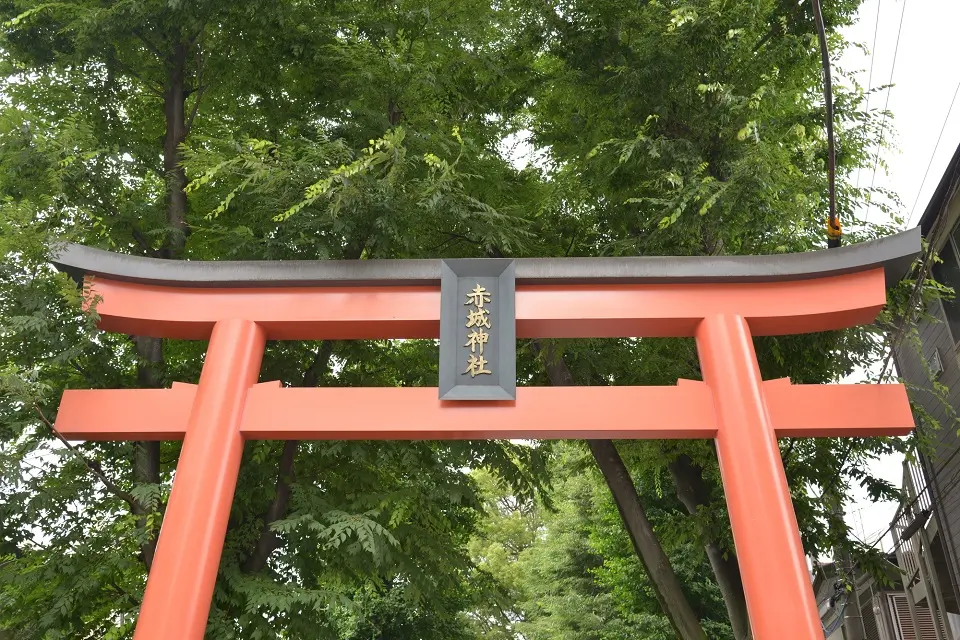
Kagurazaka is a unique area in Tokyo where you can experience a combination of traditional and modern Japanese traditions. One unique thing you will notice in Kagurazaka is a significant French influence due to the concentration of French expats in this area.
In the olden days, geisha performances were one of the main forms of entertainment for affluent people in Japan. Kagurazaka’s geisha connection dates back to the Edo era. Towards the end of the Edo period (1603 to 1868), a formal Kagurazaka district was formed, and several geisha houses were built in that area. Keeping up that tradition, Kagurazaka still maintains some geisha houses.
Train Access to Kagurazaka
You can reach Kagurazaka either from Iidabashi Station or Kagurazaka Station. The 5 options for trains to go to these two stations are as follows:
- JR Chuo Line or JR Sobu Line for Iidabashi Station
- Tozai Subway Line for both Iidabashi Station and Kagurazaka Station
- Namboku Subway Line for Iidabashi Station
- Yurakucho Subway Line: Iidabashi Station
- Toei Oedo Subway Line:
- Iidabashi Station (for going to the bottom end of Kagurazaka)
- Ushigome-Kagurazaka-cho Station (for going to the top end)
Things to Do in Kagurazaka, Tokyo
Following are the popular places in Kagurazaka and also some activities you can enjoy there:
Kagurazaka Street:
Kagurazaka’s main street has many restaurants, cafés, and shops selling traditional Japanese goods and foods. Moreover, the area has a high concentration of French expatriates because of institutions like Institut français du Japon—Tokyo and a couple of French schools nearby. Because of this high concentration of French expatriates, you can find many French eateries, bakeries, and patisseries.
Traditional Side of Kagurazaka in the Back Alleys:
If you are interested in experiencing the traditional atmosphere of Tokyo, you will certainly like the narrow back alleys of Kagurazaka with temples, small boutiques, and small cafés.
Akagi Shrine:
Akagi Shrine has a long history dating back to 1300. However, it was moved to its current location in 1555 and renovated in 2010 to give this traditional structure a modern touch.
The Akagi Shrine complex also has a modern Italian café named Akagi Café, where you can take a coffee break and relax.
Check this Google map for the directions to Akagi Shrine.
Bishamonten Zenkoku-Ji Temple:
The Zenkoku-Ji temple of Bishamonten, one of Japan’s seven lucky gods, is one of the most significant landmarks in Kagurazaka. Bishamonten is the Japanese God of war and is also considered the God who protects holy places like shrines.
The history of Zenkoku-ji temple dates back to 1595, when it was built with the support of the first shogun, Tokugawa Ieyasu. The temple’s original location was in Bakuro-cho, in the present Chūō ward. It was moved to its current location after approximately 200 years.
Dining:
Kagurazaka offers various dining options. There are several high-end kaiseki restaurants and small izakayas (Japanese casual drinking and eating restaurants). Apart from the Japanese eating joints, there are several French restaurants and wine bars due to the high concentration of French expats there.
Traditional Ryotei in Kagurazaka:
Ryotei (料亭) are traditional restaurants in Japan where you can eat while watching geisha performances. In the past, these restaurants were meeting places for business people and political leaders. The normal practice of Ryotei restaurants has been to welcome only regular clientele, and one could become a client in a Ryotei restaurant only if referred by existing clients.
However, things have changed, and some Ryotei restaurants accept new customers without any referral. If you wish to visit a Ryotei, it is advisable to call them to make a reservation.
The following are 4 Ryotei in Kagurazaka:
Shopping at Maeda-an:
Tea ceremonies have been an important part of Japanese culture and tradition. If you are interested in the Japanese tradition of tea and tea ceremonies, then Maeda-an, a store specializing in traditional Japanese tea, tea ceremony items, incense, and other traditional goods, is worth visiting place in Kagurazaka.
Cooking Classes:
Japanese food is admired for its delicacies and the health consciousness behind it. So, apart from eating and enjoying it, if you are also interested in learning to cook it, Kagurazaka has several places to take cooking lessons and prepare traditional Japanese dishes. You can find some of these places here.
Kiyosumi Gardens:
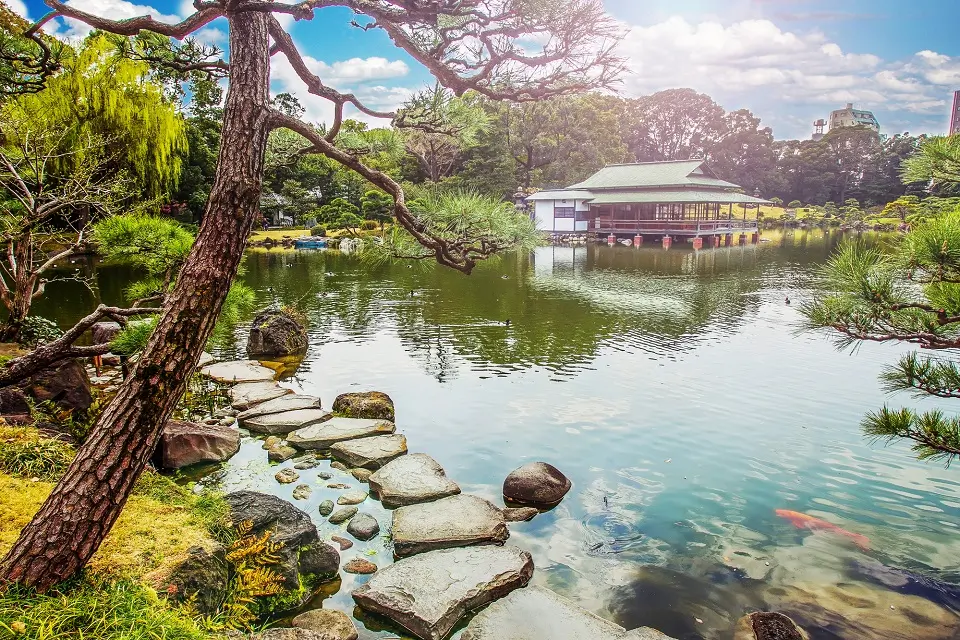
Kiyosumi Gardens (Kiyosumi Teien, 清澄庭園) is a traditional Japanese garden designed around a large pond in Tokyo’s Koto Ward. It’s a place to relax and enjoy nature in the heart of this busy city.
Kiyosumi Garden was a private garden built in 1880 by Iwasaki Yataro, the founder of Mitsubishi Corporation, during the Meiji Period. It was a place for Mitsubishi employees to relax and entertain important guests and business associates. In 1932, the Mitsubishi Group of companies transferred the ownership of this garden to the Tokyo Metropolitan Government to make it a public garden.
Train Access to Kiyosumi Gardens
Kiyosumi Gardens is a 3-minute walk from Kiyosumi-Shirakawa Station. The train options to reach this station are as follows:
- Toei Oedo Line
- Tokyo Metro Hanzomon Line
Please note that you can also access Kiyosumi Gardens by Toei Bus Line to JR Kameido Station (North Exit) or the Toyomi-suisan-futo bus to “Kiyosumiteien-mae.”
Kiyosumi Garden Features
People often call the Kiyosumi Gardens the most beautiful garden in Tokyo. Following are some of the main features of this garden:
Stepping Stone Paths:
One of the garden’s unique features is the “Iso-Watari,” a stepping stone path that leads across the shallow waters of the pond. Walking on these, you can see the fish, turtles, and water flow more closely.
Ryotei Teahouse:
There is a Ryotei teahouse right in the middle of the garden where you can rest for Japanese tea and snacks. This teahouse is housed in a traditional Japanese-style building overlooking the pond. However, it is recommended that you call them in advance to make a booking.
Birdwatching:
Being a vast garden built around a large pond, Kiyosumi Gardens attracts a large variety of birds. So, if you are interested in bird watching, this garden is probably one of the best places in Tokyo to see various bird species.
Rock Landscapes:
When the Mitsubishi group constructed the Kiyosumi Gardens, they used 55 huge rocks from different parts of Japan for landscaping. Of course, not being rock specialists, we cannot differentiate, but it is nice to know this fact that we are viewing rocks from all over the country.
Flower Viewing:
What is a garden without flowers? It is still worth mentioning that depending on the season, you can enjoy various flowers such as plum and cherry blossoms, azaleas, and irises.
Tsukiji Fish Market’s Outer Market
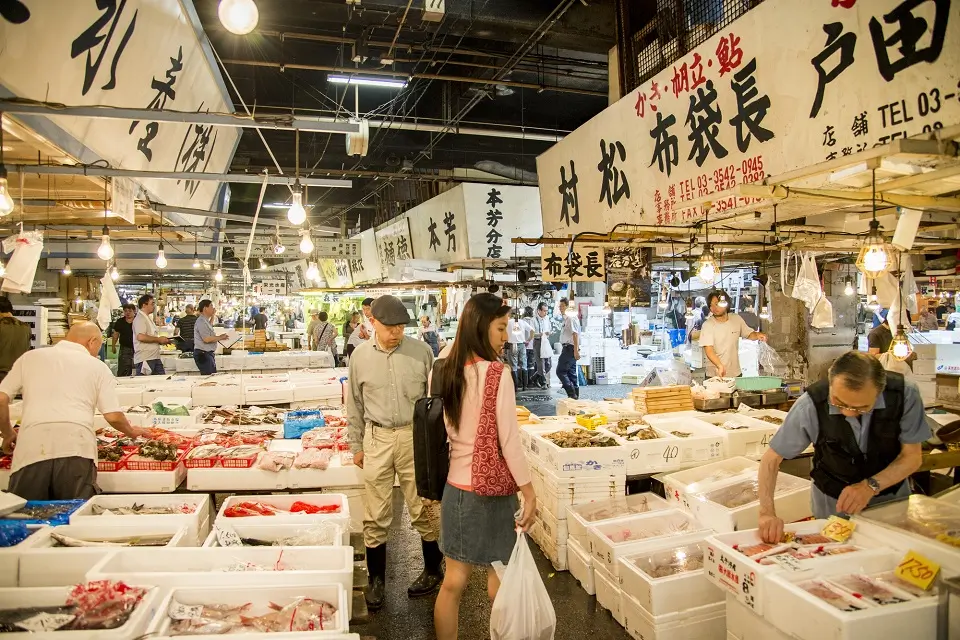
Everyone familiar with Tokyo and most who have read Tokyo guidebooks is familiar with the name “Tsukiji Fish Market.” This is obviously because Tsukiji Fish Market had the reputation of being the world’s largest wholesale fish and seafood market before the wholesale market moved to Toyosu.
The old fish market at Tsukiji had an inner market for wholesalers and an outer market for the public to buy in retail or simply enjoy fresh seafood and other street food. Now that the inner wholesale market has moved to Toyosu, the outer market of Tsukiji is still open to the public and is worth visiting in Tokyo. You can find more details here.
Train Access to Tsukiji Fish Market
Tsukiji Fish Market is conveniently accessible by four metro trains as follows:
- Toei Oedo Line to Tsukijishijo Station (1-minute walk)
- Tokyo Metro Hibiya Line to Tsukiji Station (1-minute walk)
- Toei Asakusa Line to Higashi-ginza Station (3-minute walk)
- Tokyo Metro Hibiya Line Higashi-ginza Station (3-minute)
Apart from treating yourself to the freshest possible seafood and other mouth-watering Japanese delicacies, not to forget street food, and buying Japanese pickles and sweets, etc., the following are some more things you can do at Tsukiji Fish Market’s Outer Market:
Shop for Kitchenware and Groceries:
Sellers catering to retail shoppers have been making Tsukiji’s outer market a one-stop food market. Therefore, apart from eating joints, including street food, you can also find shops that sell kitchen accessories, food ingredients, and other cooking essentials, including high-quality Japanese kitchen knives, tea, seaweed, etc. Moreover, some vendors sell fresh produce like fruits and vegetables in addition to seafood.
Tsukiji Honganji Temple:
When a society or country adopts a foreign religion, the cultural values remain, but many associated aspects fade. The society becomes a mixed entity. It’s like an adopted child: the genes of the parents stay, but the upbringing shapes the child according to the home he or she grows up in.
Tsukiji Honganji Temple is one example of a Buddhist temple that tried to keep the associated aspects of Buddhism intact. Just a few steps away from the Tsukiji market, it is a Buddhist temple famous for its unique ancient Indian-style Buddhist architecture.
The vast complex of this temple also has restaurants, a tea lounge, and an official shop. The temple’s official website is available in English here.
Namiyoke Inari Shrine:
The Namiyoke Inari Shrine (波除稲荷神社) in Tsukiji is a Shinto Inari shrine which was built in the 16th century.
The kanji 波 in the name Namiyoke means wave and 除 means ‘remove’ or “get rid of.” As the name suggests, the Namiyoke Inari shrine was built to bless the area against natural disasters, especially from the ocean. Even today, traders in the Tsukiji market consider it their guardian shrine. You can Google translate this page of the shrine’s website to read about its interesting history.
Sushi and Japanese Food-Making Classes:
Enjoy eating sushi? Well, why not enjoy the experience of making sushi also?
There are many cooking classes near the Tsukiji fish market, where you can learn the art of preparing sushi and other Japanese food items. These classes include Tsukiji Cooking, Earth Kitchen, and Tokyo Sushi Academy. You can find more cooking classes in Tsukiji here.
Sake Breweries in Tokyo
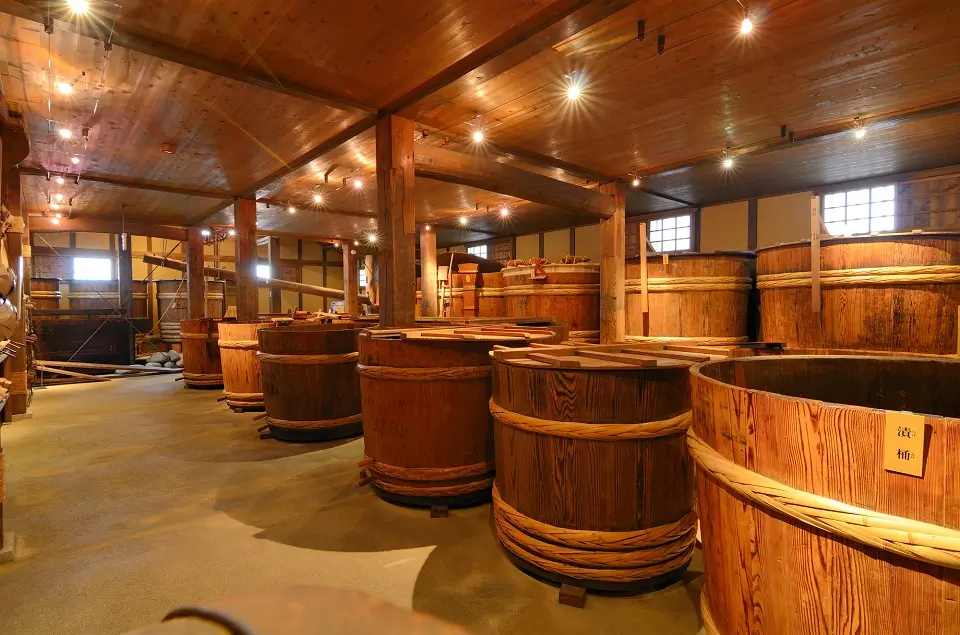
Wouldn’t it be more fulfilling to combine a sightseeing trip to Tokyo with learning and experiencing various Japanese traditions and practices?
We already mentioned several cooking classes in Tokyo where you can learn Japanese cooking. Similarly, there are several sake breweries in and around Tokyo, where visitors can learn about the traditional process of making this Japanese alcoholic beverage made from fermented rice.
Following are some of the popular sake breweries in Tokyo that you can visit to experience the process of brewing sake:
Ishikawa Brewery:
The Ishikawa Brewery in Fussa City in the western part of Tokyo has been in operation since 1863. This brewery offers tours where you can learn about the sake brewing process and know the brewery’s history. These tours also have sake-tasting sessions where you can taste different types of sake.
Ozawa Brewery:
Like the Ishikawa Brewery, the Ozawa Brewery is located in the western part of Tokyo, more specifically, in Ome City. It has operated since 1702 and is famous for its Sawanoi brand.
The foreigner-friendly tours of this brewery are not only free, but you may also get an English guide if you book in advance. During this tour, you can also taste their sake. Moreover, Ozawa Brewery is in a scenic area near the Tama River, and you can enjoy the scenery outside the brewery.
Tokyo Port Brewery:
The Tokyo Port Brewery makes sake and beer near the Tokyo Bay area. Like the other breweries mentioned above, it offers tours of its facility, including sake tasting.
Please note that the tour of the facilities will require a reservation, so it is recommended that you check the breweries’ official websites and contact them to confirm the availability of tours.
Flea Markets in Tokyo
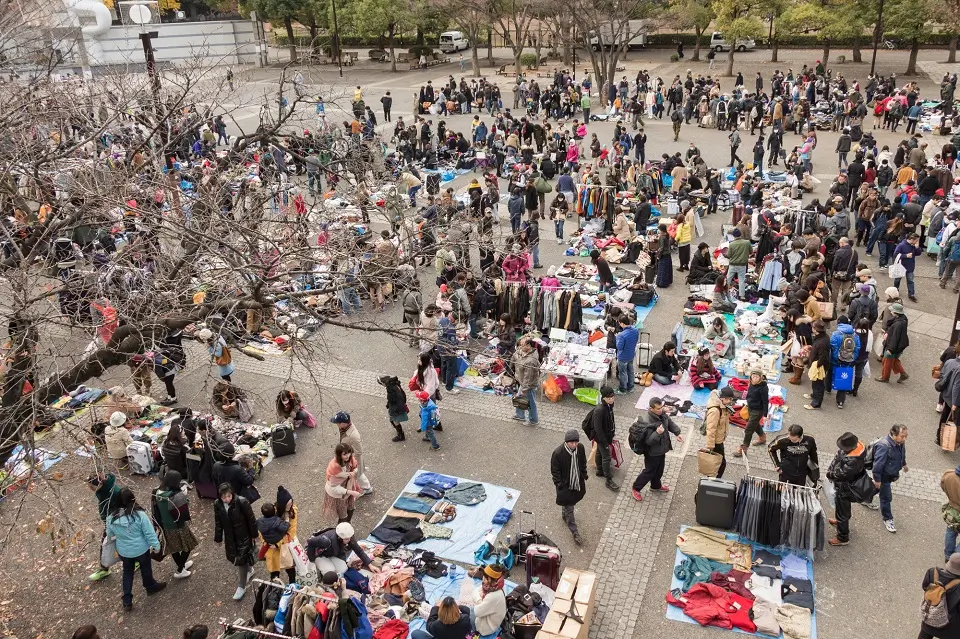
Visiting the flea markets in Tokyo is a good experience. These markets are an opportunity to purchase traditional Japanese household items at affordable prices and peek into the traditions. You can find various goods in these markets, from vintage clothes and antiques to local crafts.
Moreover, these markets also have stalls for delicious Japanese street food. Most flea markets in Tokyo are normally held on weekends or specific dates each month. Some flea markets take place around major shrines during the New Year.
Following are the popular flea markets in Tokyo:
Ohi Racecourse Flea Market:
The Ohi Racecourse Flea Market in Shinagawa, also known as the Tokyo City Flea Market, occurs on weekends. This Flea Market is one of the biggest in the city, with several hundred vendors selling various household items on a good day.
Mottainai Flea Market:
‘Mottainai’ is a Japanese term for regretting the waste of anything, and it is a fitting name for a Flea market.
These Mottainai Flea Markets are not held at a fixed location; they occur at different locations in Tokyo, generally in parks. They publish their flea market schedule on their event calendar, and you can check it here.
Setagaya Boroichi Market:
Held in Setagaya, Setagaya Boroichi Market has been taking place for over 400 years and is designated an intangible folk cultural asset of Tokyo. It takes place annually on December 15-16 and January 15-16, where you can find antiques, clothes, food, plants, and many other items.
Shinjuku Chuo Park Flea Market:
Shinjuku Chūō Park Flea Market is a relatively small flea market. The word Chūō (中央) means ‘central’ in English, so, as the name suggests, this flea market is held in Shinjuku Central Park. It’s a great place to find vintage clothing and handmade crafts.
Hanazono Shrine Antique Market:
If you are interested in Japanese antiques, the Hanazono Shrine Antique Market is a good place to find them. This Flea Market is held on Sundays at the Hanazono Shrine in Shinjuku.
As all these flea markets are in open spaces, rainy days may prevent them from taking place. Moreover, some flea markets may not operate during winter; therefore, it is better to check the schedule updates when you wish to visit one.
Moreover, vendors are local people, and most do not speak English. Therefore, knowing a few basic Japanese phrases would be handy. However, not knowing Japanese is not a roadblock if you see an item you like to buy without being curious about the details.
Google Map for Tokyo’s Main Flea Markets
Art Museums and Galleries in Roppongi
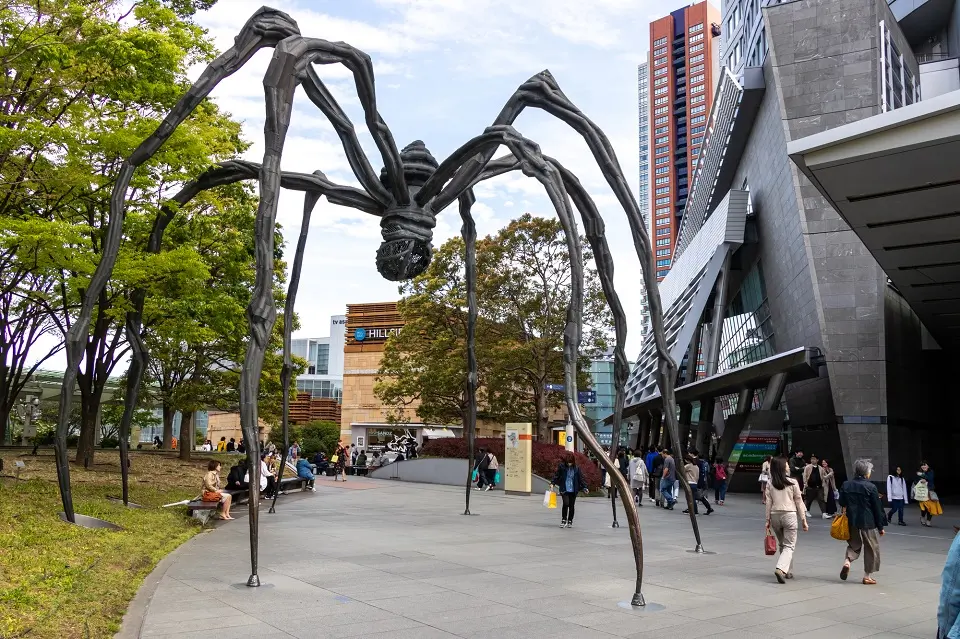
Roppongi district of Tokyo is quite famous among foreigners. While Roppongi and its neighborhood have several foreign embassies, Roppongi is also a business district with offices of companies like Google, Apple, Barclays, Mercari, and many more.
With a high concentration of foreigners in and around Roppongi, the area is the most famous nightlife hub, especially among foreigners and young Japanese. In contrast, it also features several art museums and galleries.
Train Access to Roppongi
You can reach Roppongi Station using one of the following two train lines:
- Tokyo Metro Hibiya Line
- Toei Subway Oedo Line
Notable Museums and Galleries
Following are some of the notable museums and galleries in Roppongi:
Roppongi Art Triangle:
The Roppongi Art Triangle has the following three museums:
- Mori Art Museum
- National Art Center, Tokyo
- Suntory Museum of Art
These three museums are within walking distance of each other and showcase art items from Japan and other countries. The art display ranges from traditional Japanese artworks to modern, innovative installations.
Mori Art Museum:
Since 2003, the Mori Art Museum has been on the 53rd floor of the Roppongi Hills Mori Tower. It is a must-see for contemporary and architectural art lovers. The museum focuses on contemporary Asian artists but also hosts a wide range of exhibits by artists worldwide in all categories.
The Mori Art Museum’s official website lists the current and upcoming exhibitions, which can help you schedule your visit dates if you are flexible. Please note that in addition to the exhibitions, the museum also conducts various art-related learning programs suited to various audiences.
With the tickets to the Mori Art Museum, you can also visit the Tokyo City View observation on the previous floor, i.e., the 52nd floor. This observation deck, 250 meters above sea level, offers a great view of Tokyo.
The museum also features a state-of-the-art restaurant where you can take a break. The restaurant’s artistic interiors will keep you in the same state of mind as you are in the museum.
Apart from the Mori Art Museum, you can also explore the Roppongi Hills area, which has modern office buildings, apartments, shops, restaurants, a hotel, a TV studio, and a large outdoor amphitheater.
The National Art Center, Tokyo:
The National Art Center, with Japan’s largest exhibition space of 14,000 sqm, has no permanent exhibits but hosts various temporary visual arts exhibitions. You can find more details here.
In addition to the art exhibition, you will admire the building’s great modern architecture, designed by Kisho Kurokawa.
Suntory Museum of Art:
Suntory Museum of Art focuses on traditional Japanese art. Its collection includes over 3,000 art objects, including Japanese ceramics and pottery. The museum also hosts various temporary art exhibitions.
In addition to enjoying the exhibits, the Suntory Museum of Art offers a glimpse into various Japanese traditions through learning programs designed for various audiences and by giving visitors the opportunity to experience tea ceremonies, an important part of Japanese culture.
Roppongi Art Night:
Apart from the above-mentioned museums, Roppongi also holds a biannual event called Roppongi Art Night. During these events, various art installations, performances, and workshops are held.
21_21 Design Sight:
The name 21_21 Design Sight is based on the mission to have a museum that offers things beyond the normal 20/20 vision of human eyes. However, the name 21_21 does not have a scientific basis and is only an artistic statement, as numbers greater than 20/20 do not represent better than normal vision.
This museum was established in 2007 by Fashion designer Issey Miyake and architect Tadao Ando. Its focus is on design in everyday life. In addition to its permanent exhibits, the museum also hosts various temporary exhibitions throughout the year.
Art Galleries in Roppongi:
Apart from the major museums mentioned above, the Roppongi area also has several smaller art galleries. The focus of these smaller but popular art galleries is often to showcase the art of emerging artists. Some such galleries are Ota Fine Arts, Taka Ishii Gallery, and Zen Foto Gallery.
Map for The Places to Visit in Roppongi
Ryokan Stay Experience in Tokyo
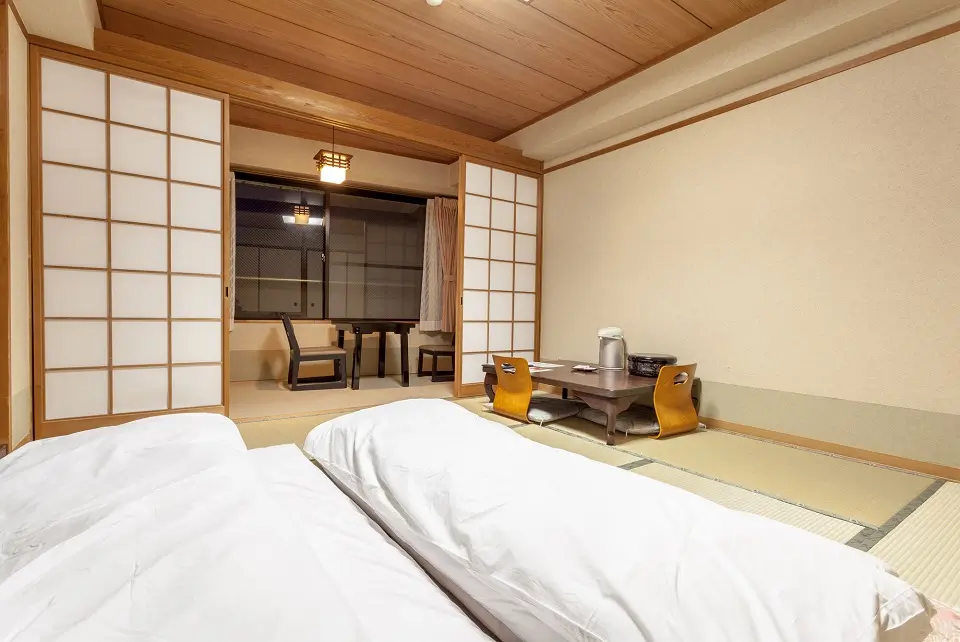
The word Ryokan (旅館) is made by two Kanji characters 旅, meaning “journey) and 館, which means “hall”. As the name suggests, a ryokan is a Japanese inn or a place one can stay during one’s journey.
As the name Ryokan suggests, these inns originally supported travelers who needed lodging along the intercity roads during their long journeys.
Today’s ryokans don’t just serve travelers but are rather expensive accommodations serving families during their travels to Japan’s hotspots.
However, as traditional lodges, ryokans maintain their traditional feel even today. They have traditional tatami-matted flooring, where you sleep on a futon on the floor. Traditional multi-course dinner (kaiseki) and breakfast are served in the rooms. You can also enjoy onsen baths inside a ryokan.
Staying in Ryokan not only gives you a peek into Japanese traditions but is also a remarkable experience.
If you are short on time and do not plan to visit rural parts of Japan for an authentic Ryokan experience. In that case, there are several ryokans in Tokyo and the surrounding regions where you can have the traditional experience.
The following are some of the popular ryokans in Tokyo:
Hoshinoya Tokyo:
Hoshinoya Tokyo is a luxury Ryokan located in Tokyo’s Otemachi area. Traditional ryokans are generally single-story buildings; however, the Hoshinoya Ryokan has 19 floors, including 2 basement floors. That way, the building is not similar to a traditional authentic ryokan, but you can get the taste of staying in one inside your loading.
With 6 rooms on each floor, Hoshinoya’s each floor is like a mini ryokan. Moreover, unlike a traditional ryokan, it also has a lounge area where guests can sit and have tea and snacks. The combination of the above features gives a traditional Ryokan experience with a modern touch.
Homeikan:
Homeikan Ryokan, near the University of Tokyo in Bunkyo Ward, is a budget-friendly ryokan with a long history dating back to the Meiji Era. Please note that Homeikan does not accept credit card payments.
Sawanoya Ryokan:
Sawanoya Ryokan is a family-run ryokan in the Yanaka district near Ueno of Tokyo. It is famous for its warm hospitality. Like Homeikan, Sawanoya Ryokan is quite affordable, with simple, traditional rooms and onsen facilities. However, unlike Hoeikan, Sawanoya accepts credit cards.
Ryokan Katsutaro:
Like Sawanoya Ryokan, Ryokan Katsutaro is in the Yanaka district of Tokyo. It has a traditional atmosphere with many temples and shrines nearby.
Ryokan Experience Closer to Tokyo
If you’re willing to go a bit outside of Tokyo, you can find ryokans in areas famous for their hot springs. Some of the popular options are as follows:
Hakone:
No Japan tourist guidebook is complete without mentioning Hakone, a very popular hot spring resort area not far from Tokyo. Depending on the type of train, you can reach Hakone in 50 to 90 minutes.
Hakone has several Ryokans, from luxury options like Hakone Ginyu and Hyatt Regency Hakone Resort and Spa to more budget-friendly ones like Hakone Tent.
Kawaguchiko:
The Kawaguchiko area near Mount Fuji is also famous for ryokans with views of Mount Fuji. Some of the options here include Konansou and Kozantei Ubuya.
Bunkyo Ward: Modernity with Traditional Touch
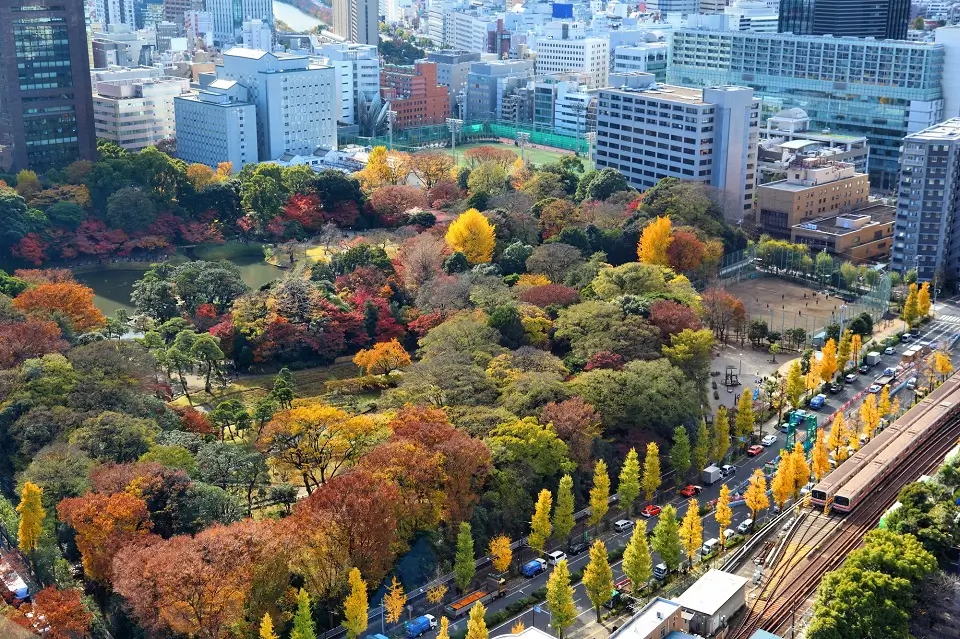
Bunkyo Ward is one of the 23 wards of Tokyo where you can experience modern city life with several traditional attractions. This ward is also famous as Tokyo’s “educational center” because of various universities, including the University of Tokyo. Moreover, the Bunkyo ward also has several other educational and cultural institutions.
Following are some activities and attractions that you can explore in the Bunkyo Ward:
Koishikawa Kōrakuen Gardens:
Designed and constructed during the early Edo period, Koishikawa Kōrakuen is one of Tokyo’s oldest and most beautiful Japanese gardens.
Please note that all gardens in Japan are not Japanese gardens because the term Japanese Garden has a specific meaning. Japanese gardens are differentiated from others because of the influence of traditional Japanese aesthetics and philosophical concepts. They are admired for their natural landscaping not only because of their design but also because of their construction material.
No Japanese garden is complete with large ponds, and Koishikawa Kōrakuen is no exception. The garden has a central pond, picturesque artificial hills, and stone lanterns among its soothing greeneries.
The University of Tokyo:
The University of Tokyo (東京大学 / Tokyo Daigaku), or Todai, is the top-ranked university in Japan.
With a history dating back to 1877, the vast Hongo campus in the Bunkyo ward of Tokyo University has many historical buildings and beautiful natural surroundings.
The University of Tokyo allows free campus tours and even offers services by their students as tour guides to show the campus.
Tokyo Dome City:
Tokyo Dome City got its name from the Tokyo Dome, the largest roofed basketball court in the world. However, apart from the Tokyo Dome, it is a massive complex that attracts visitors for various entertainment and leisure activities.
Apart from the Tokyo Dome, these attractions include an amusement park and an arena called Korakuen Hall, which hosts combat sports, such as boxing, wrestling, martial arts, etc. Tokyo Dome City also has a large spa called LaQua Spa, a hotel called Tokyo Dome Hotel, a bowling center, various shops and restaurants, etc.
Bunkyo Civic Center:
Very close to the Tokyo Dome City, the 25-floor Bunkyo Civic Center building has an observatory on its top floor. From here, you can enjoy a panoramic view of Tokyo for free. If you happen to be there on a clear day, you can also see Mount Fuji.
Nezu Shrine:
Nezu Shrine is a Shinto shrine and one of the oldest shrines in Japan. Its popular vermilion torii gates create a tunnel similar to Kyoto’s famous Fushimi Inari Shrine. If you happen to be in Tokyo from April to May, you may not want to miss the famous azalea festival held at Nezu Shines’ vast azalea garden, which has 100 species of azalea plants.
Koishikawa Botanical Garden:
The University of Tokyo manages the Koishikawa Botanical Garden in Bukyo ward. This botanical garden has 4,000 live plant species and about 800,000 preserved plant species (herbarium).
Like most gardens, autumn and spring are the best seasons to appreciate its beauty. However, as it’s a botanical garden, if you visit it because of professional or educational interest, you should not miss it regardless of the season.
Map of Places of Interest in Bunkyo Ward, Tokyo
Odaiba
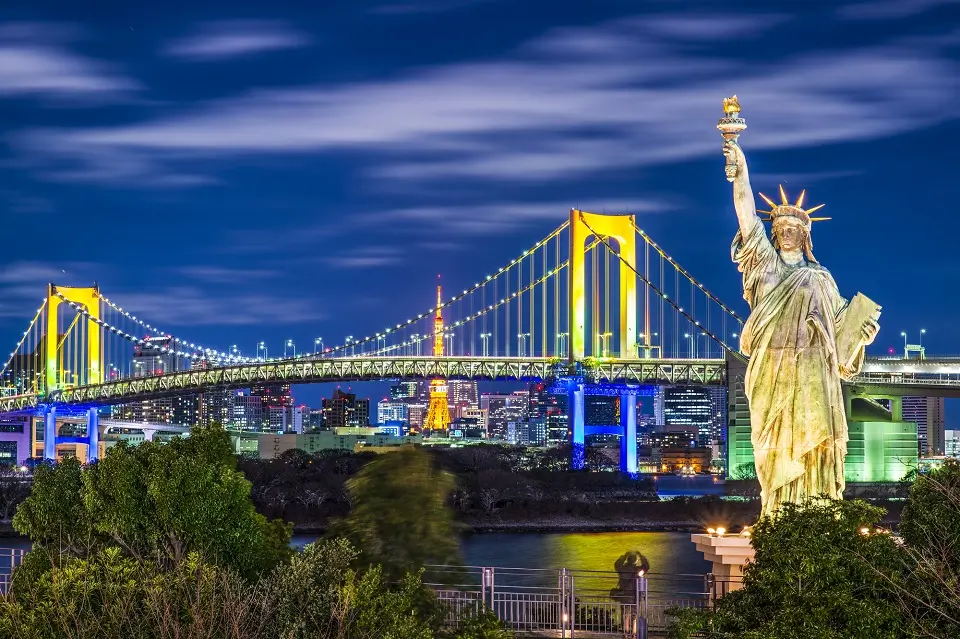
The Odaiba area near Tokyo Bay is a beautiful area. Though modern, its wide roads and relaxed atmosphere contrast with downtown Tokyo.
Odaiba’s history dates back to the 1850s when a small area was built there on reclaimed land. However, Odaiba witnessed a huge expansion as a seaport district during the late 20th century. Since then, it has developed as a major commercial, residential, and leisure area.
Following is a list of activities and attractions you can enjoy in Odaiba:
Palette Town:
Odaiba’s Palette Town is a large shopping and entertainment complex with a large shopping mall called “VenusFort.”
Japan’s fascination with European styles in many areas is not a much-talked-about fact. This European influence in construction is unsurprising, considering that Japan’s connection with Portugal, a South European country, goes back to 1543. Even after that, this otherwise historically closed country became more exposed to Europe in the Western world while opening up.
You can witness the European influence in Yokohama, the pensions in the Izu peninsula, and many independent houses. Similarly, The Palette Town shopping mall was constructed to give a look and feel of an old South European town from the 18th century. The Palette Town also has one of the largest Ferris wheels in the world, called Daikanransha.
Odaiba Seaside Park:
Odaiba Seaside Park is an artificial beach edging Tokyo Bay. It offers beautiful views of the Rainbow Bridge and the Tokyo skyline. Visitors can relax on the beach, walk along the promenade, or try the water sports available.
Aqua City:
Aqua City in Odaiba is a large shopping mall with various stores, including large ones with diversified merchandise, boutiques, and various restaurants. The mall also has a 13-screen cinema complex and an excellent ramen food court where you can try different regional styles of ramen.
Decks Tokyo Beach:
Decks Tokyo Beach is a shopping mall in Odaiba district with themed areas, such as Little Hong Kong & Tokyo Trick Art Museum, with fun optical illusions. It also houses LEGOLAND Discovery Center Tokyo and Madame Tussauds Tokyo.
Fuji TV Building:
You can tour the building of one of Japan’s private, nationwide TV stations. You can see exhibits on popular programs, buy related goods, and access the futuristic-looking building’s observatory deck.
Oedo Onsen Monogatari:
Oedo Onsen Monogatari is a hot spring theme park that recreates the atmosphere of the Edo Period in Japan. Visitors can enjoy various types of baths, including those using natural hot spring water pumped from the depths of Odaiba.
Megaweb Toyota City and History Garage:
If you are an automotive, especially car lover, you would love being at the Megaweb Toyota City and History garage in Odaiba. Toyota Mega Web is often called a theme park for car enthusiasts. Located in Odaiba’s Palette Town, it provides visitors with an interactive experience related to everything Toyota. The Mega Web is divided into three main areas:
Toyota City Showcase:
Toyota City Showcase allows you to see and admire the latest Toyota models and ride them. If you have a valid driving license recognized in Japan, you can also test-drive the cars on a dedicated driving track.
Toyota Universal Design Showcase:
This section, known as the Toyota Universal Design Showcase, gives you a glimpse of the future of automotive designs and technologies.
Like any technological field, unlike in the past, all major automotive companies have been growing technologically in the same direction. Their technological growth velocities may differ in speed but not in direction. Therefore, Toyota’s Universal Design Showcase showcases next-generation mobility solutions and advanced IT-integrated systems from Toyota and the global car industry.
History Garage:
A peek into history is as important and joyful as a peek into future possibilities. Almost every car lover loves those beautiful antique cars, big or small. The History Garage of Toyota gives you a chance to admire the restored antique vehicles of Toyota and other manufacturers.
In this History Garage, you’ll see a collection of iconic vehicles from Europe and the United States, too. This retro-themed garage is designed to resemble the streets of Tokyo from the Showa era (1926-1989), providing a nostalgic atmosphere.
The History Garage also has a library covering the history of automobiles, making it a great stop for car enthusiasts and automobile history buffs.
DiverCity Tokyo Plaza:
DiverCity Tokyo Plaza shopping complex in Odaiba has various brand stores and restaurants. It also has a large store named Gundam Base Tokyo, a store related to the Gundam anime franchise.
If you are into action figures, you will admire their large collection of action figures and goods related to Gunpla. Apart from the merchandise, they also have exhibitions of Gundam models, including a life-sized Gundam statue.
Yurikamome Train Line:
Lastly, don’t miss a ride on the fully automated Yurikamome Line, which connects Odaiba to the mainland. If you manage to get the right seat, especially the front seat, you will love the lovely views of the city and Tokyo Bay, with the winding overhead tracks of the train.
Odaiba provides a fun-filled day for all age groups with its shopping, knowledge-gathering, and entertainment options, which are a nice contrast to Tokyo’s traditional, even though modern, sights.
Map of Places of Interest in Odaiba
TeamLab Borderless Digital Museum
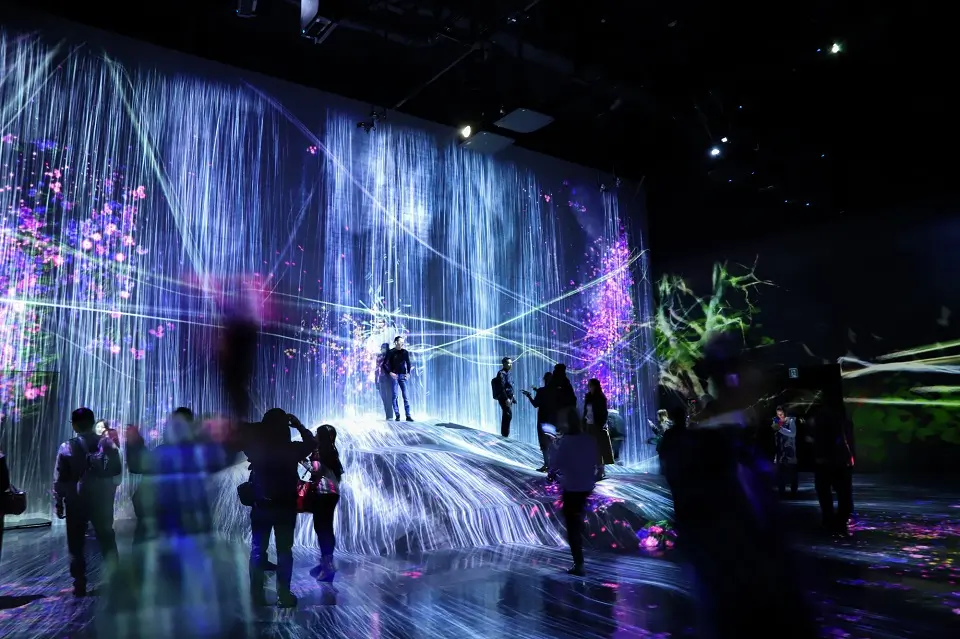
TeamLab Borderless, a digital art museum, was previously located in Odaiba, Tokyo. Starting February 9th, 2024, its new location is Azabudai Hills in Central Tokyo.
Opened in 2018 in Odaiba, now in Azabudai Hills in Central Tokyo, TeamLab Borderless Museum is a digital art museum.
This futuristic digital museum is a collaboration between the real estate and property management company “Mori Building” and teamLab, a renowned Japanese art collective and a group of artists.
The “borderless” in the name suggests an interactive and immersive presentation of high-dimensional art without borders between the art and the viewers.
The following are the main attractions of the teamLab Borderless:
Interactive Artworks:
The museum features around 60 interactive and continuously in-motion artworks that respond to the viewer’s presence. These digital artworks are not confined to specific rooms or spaces and continuously move and interact with each other. It’s a futuristic experience to watch them influencing and sometimes intermingling with other works.
Forest of Resonating Lamps:
Forest of Resonating Lamps is one of the most popular installations in the teamLab Borderless Museum. It’s a room with many hanging lamps that change colors and respond to human presence and interaction. The lamps light up when they detect a person and then send a resonating color to the nearest lamps, creating a continuous chain of light that spreads like a wave.
Forest of Flowers and People:
As the name suggests, the Forest of Flowers and People in teamLab Borderless is a huge space with blooming seasonal flowers. However, being in a digital museum, those are digital flowers, but they are a real treat to the eyes.
It is called the Forest of Flowers and People, not just the Forest of Flowers, because the flowers also react to the visitors’ movements. It’s a surreal experience to watch the flowers as though they are also watching you and feeling your presence.
Athletics Forest:
Athletics Forest is an interactive space designed to train spatial awareness, which includes a trampoline universe, a three-dimensional bouldering climbing space, and a light forest of resonating orbs.
Crystal World:
The room known as the Crystal World in teamLab Borderless is full of interactive dangling LED lights. Visitors can control these lights using a smartphone app to change their colors. This room gets its name as the “Crystal World” because it makes you feel as if you are inside a giant crystal, the crystal world.
Please note that the teamLab Borderless is quite popular, and tickets are often sold out, especially on weekends and holidays. Therefore, buying them online in advance is highly recommended.
Ghibli Museum
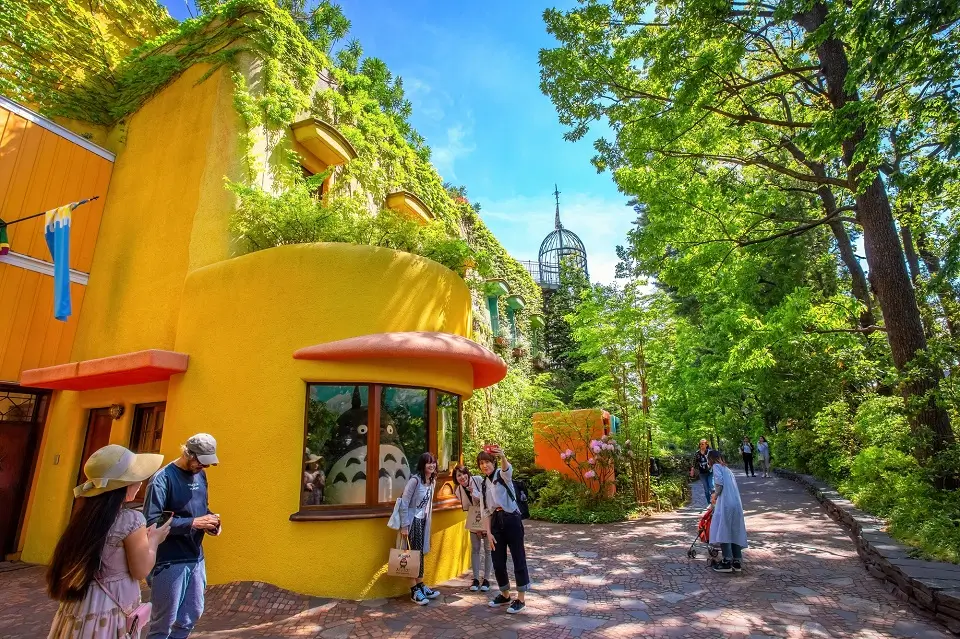
If you are an anime fan, you are unlikely to be unfamiliar with Studio Ghbli’s anime productions.
Japan’s most famous anime director, Hayao Miyazaki, co-founded Studio Ghibli. The Ghibli Museum in Mitaka, on the western side of Tokyo, features the studio’s various anime works. It’s a fun place admired not just by children but by people of all ages, whether they are anime fans or not.
Please note that with limited daily entries and admissions only by reservation, you should check the official Ghibli Museum website for the most up-to-date information and make reservations.
Access to the Ghibli Museum
The Ghibli Museum is 15 to 20 minutes walk from the following Stations:
From the JR Mitaka Station, you can even take a community bus to the museum, which has a frequency of 10 to 20 minutes. There is a ticket vending machine near bus top #9 to purchase bus tickets.
Attractions at Ghibli Museum
Following are some of the features and attractions of the museum:
Architecture and Design:
The Ghibli Museum’s design is similar to the settings in many Ghibli films. Several architectural effects from Ghibli Studio’s various movies are present throughout the museum. If you have seen those movies, you will certainly enjoy the feeling of seeing them in real life.
Exhibits:
The Ghibli Museum has various permanent and temporary exhibits. You can see and learn about the creative process of animation, including replicas of the studio where the films are made. You will also have an opportunity to see periodically changing temporary exhibits highlighting different aspects of Ghibli’s works.
The Saturn Theater:
A small theater known as the “Saturn Theater” of the museum plays short films by Studio Ghibli that are exclusive to the museum. This theater shows a different film every month.
The Catbus Room:
One of the museum’s favorite rooms is the “Catbus Room,” where children can play on a life-sized Catbus from “My Neighbor Totoro.”
The Rooftop Garden:
The museum has a rooftop garden with a life-sized robot soldier from the movie “Castle in the Sky.” Apart from relaxing, this garden is also a great spot for taking pictures.
Straw Hat Café:
You can stop to relax and eat in the Ghibli Museum’s café called Straw Hat Café. Like everything else in the museum, even the food and desserts in the museum’s “Straw Hat Café” are inspired by the food seen in Ghibli films.
Museum Shop:
You can purchase various Ghibli merchandise as souvenirs from the museum shop known as “Mamma Aiuto.” Many of the merchandise in this shop is exclusive to the museum and not available elsewhere.
Kappabashi Kitchen Town
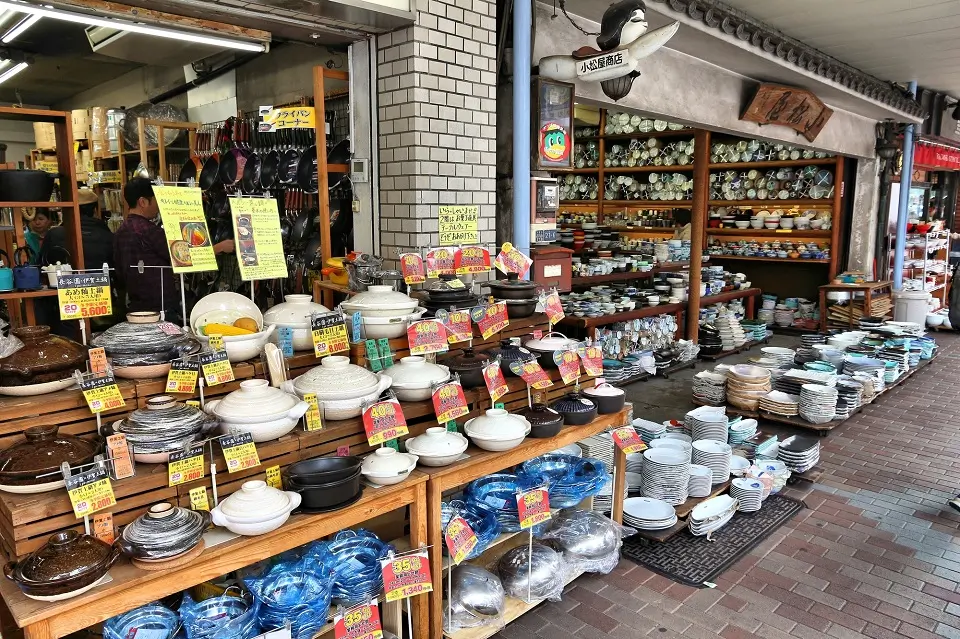
Tokyo’s Kappabashi Kitchen Town, or Kappabashi Dougu Street, is a shopping street known for its extensive selection of kitchenware and cooking-related retail stores.
With an extensive range of famous traditional ceramicware and other kitchen items, Kappabashi Kitchen Town allows a peek into Japan’s traditional culinary culture.
Apart from the kitchenware shops, this market also has several outlets exclusive to the world-famous Japanese kitchen knives. Kitchen knife shops such as Kamata and Kama-Asa also engrave the knives for you.
The following are other things you can find and do in Kappabashi Kitchen Town:
Plastic Food Models:
I am sure that you must have admired the natural-looking plastic food models displayed outside Japanese restaurants. In Kappabashi, several shops specialize in these plastic food models, from sushi to ramen to desserts. It’s fun to browse and maybe buy these models as souvenirs.
Bento and Related Supplies:
Bento is the Japanese equivalent of a lunch box. Bento boxes are traditionally wooden; however, nowadays, there are plastic bento boxes with a wooden look. In Kappabashi Kitchen Town, you’ll find a variety of bento boxes, dividers, rice molds, and cute cutters for shaping vegetables.
Tableware and Ceramics:
Kappabashi also offers an extensive range of Japanese pottery and ceramic tableware. You can purchase or admire elegant tea sets and beautifully crafted plates and bowls in traditional and modern styles.
Coffee and Tea Shops:
You can also find shops in Kappabashi that sell a variety of coffee and tea brewing equipment, as well as high-quality coffee beans and tea leaves.
Bakery Equipment:
If you love baking, you’ll find shops selling bakery equipment, decorative items, and cake-making tools.
Access to Kappabashi Kitchen Town
Kappabashi Kitchen Town is between Ueno and Asakusa stations. You can take a short walk to reach this amazing place from either of these two stations.
Shimokitazawa and its Small Retail Shops
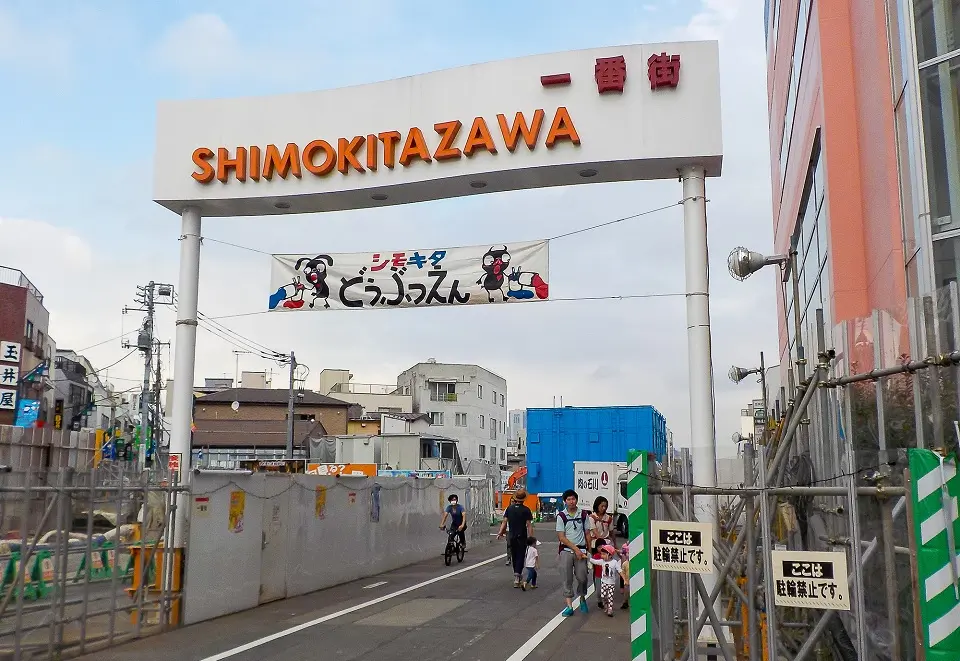
Shimokitazawa, often known simply as “Shimokita,” is a neighborhood in Tokyo famous for its trendy atmosphere and many small retail shops. In Shimokitazawa, You will also find a variety of cafés, theaters, bars, and music venues.
Shimokitazawa is a popular area among students and young professionals. Because of its hip, alternative scene, it is often compared to New York’s East Village or Brooklyn.
Access to Shimokitazawa
Shimokitazawa Station is accessible by the following two train lines:
- Keio Inokashira Line
- Odakyu Line
Things to Do in Shimokitazawa
Here are some things to do and discover in the Shimokitazawa area of Tokyo:
Thrift Shopping:
Shimokitazawa is considered Tokyo’s thrift store capital. Many shops in Shimokita sell vintage and secondhand clothing, unique accessories, and retro furniture. Shops like New York Joe Exchange, Flamingo, and Haight & Ashbury are worth checking out.
Live Music and Theatre:
Shimokitazawa is also famous for its lively music scene. Numerous small live houses and theaters in this area host performances ranging from local independent bands to traditional theatre. You can find some of such theatres here.
Cafés and Restaurants:
With its popularity among the younger generation, Shimokita has many unique and cozy cafés and eateries. You can find various dining options, from organic, vegetarian, and vegan food to traditional Japanese and international cuisine.
Festivals:
If you’re in Shimokitazawa at the right time, you might catch one of the local festivals, such as the Shimokitazawa Tengu Festival, a traditional event with a parade, or the Shimokitazawa Sound Cruising, a music festival.
Shimokitazawa offers a unique, off-beat experience that contrasts with the ultra-modern image of districts like Shibuya or Shinjuku. It’s a great place to explore for those looking to experience a more laid-back side of Tokyo.
Explore Tokyo from the Water
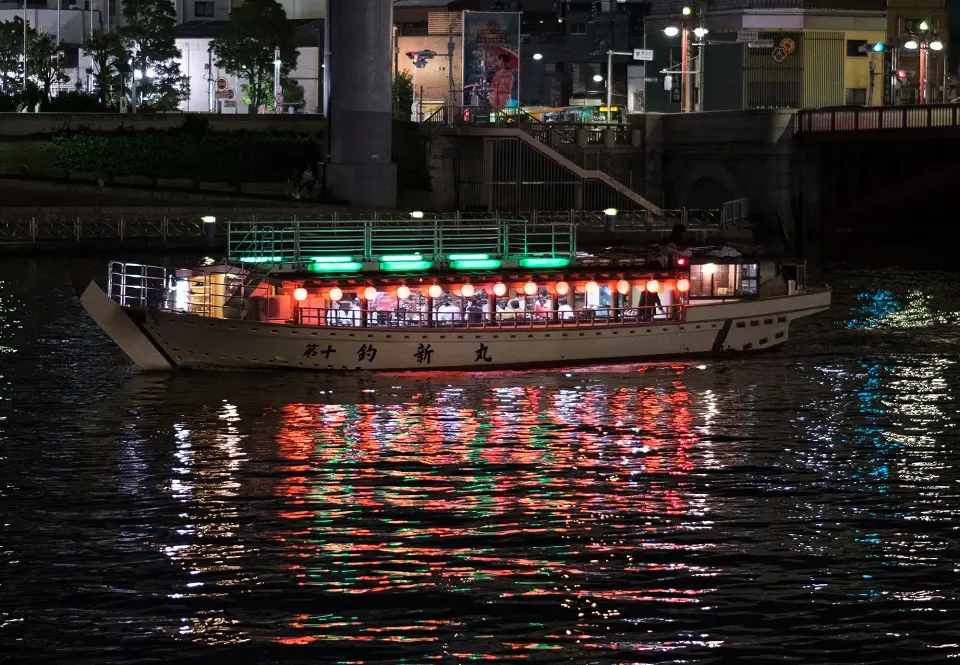
Exploring Tokyo by road or train is good for seeing specific tourist attractions. However, traveling on a boat across the city can make you appreciate the city in its entirety. Exploring Tokyo from the water is a unique experience as It’s like watching the city by being in it but feeling as if seeing it from a distance.
One of the main waterways for exploring Tokyo from the water is the Sumida River. The famous Sumida River flows through Tokyo and offers views of many iconic landmarks.
Here are some ways you can explore Tokyo from the water:
Sumida River Cruise:
Several companies offer river cruises along the Sumida River, with boats departing from several locations. However, one of the most common routes is from Asakusa to Odaiba.
During the cruise, you’ll see numerous Tokyo landmarks, including the Tokyo Skytree, the Asahi Beer Hall, and the Rainbow Bridge.
Many of the cruises offer commentary, which is usually in Japanese. However, because there are a large number of foreign tourists, many such river cruises have English audio guides available. It is better to enquire about English support in advance for this guidance in explaining the sights along the route.
Hotaluna, Himiko, and Emeraldas Water Buses:
Hotaluna, Himiko, and Emeraldas cruises have futuristic-looking boats that resemble objects from a science-fiction movie. Anime creator Leiji Matsumoto designed these boats.
The cruising routes are the same as the regular river cruises of Tokyo; the scenery outside remains the same; what changes is the experience of being in a futuristic-looking boat, which doesn’t represent technology but artistic objects by a famous artist.
If you are looking for a more stylish way to cruise the river. Hotaluna, Himiko, and Emeraldas cruises offer that style with larger windows and more comfortable seating. You can find the access points and timetables here.
Traditional Yakatabune Cruises:
We just talked about futuristic-looking boats, but are you in Japan just to experience space, rockets, and robots? Or will you find it worthwhile to take a peek into traditional Japan and its culture?
Well, if I have to decide, I would love to have both tastes – obviously the first preference for the latter. So, here comes into the picture Yakatabune (屋形船).
Yakatabune is a traditional Japanese houseboat; however, if we notice the combination of Kanji characters, it is 屋 (shop) + 形 (shape) + 船 (boat), which literally means a “shop-shaped boat”. Therefore, the meaning of a Yakatabune is not literal but conceptual because a Yakatabune is not just a means for people to travel across waters; it is like restaurants sailing through water.
Several companies offer cruises on Yakatabune, and a cruise in these can be a fun way to combine sightseeing with experiencing traditional Japanese culture.
Cherry Blossom Viewing Cruises:
The above-mentioned river cruises in Tokyo are regular cruises that you can take to enjoy Tokyo at any time of the year. However, if you happen to be in Tokyo during spring, more specifically during the cherry blossom season (Sakura), you may not want to miss the cherry blossom cruises.
These are seasonal cruises operated by some companies. Normally, you can admire the blooming cherry blossoms by going to a specific area. However, these river cruises give you an opportunity to see Sakura throughout the river.
The Sumida River is lined with cherry trees, and a river cruise can be a wonderful way to experience the sights of the Sakura season.
Canal Café Boat Rental:
Near Iidabashi Station, the Canal Café offers the opportunity to rent small rowboats and paddle along the outer moat of the former Edo Castle. It’s a quieter, more intimate experience for families or friends than larger river cruises. During summer, you can rent rowboats for 600 yen per 30 minutes.
Shopping at Nakano Broadway
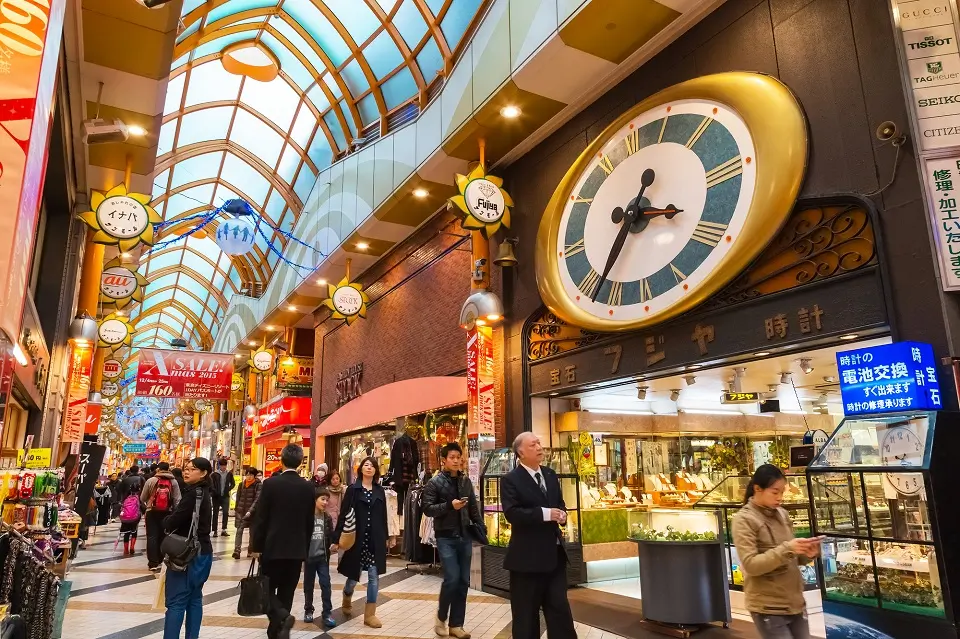
The shopping complex Nakano Broadway is located in Tokyo’s Nakano ward. Like Akihabara, Nakano is also famous among Otaku lovers.
Train Access to Nakano Broadway
Nakano Broadway is a short walk from Nakano Station, accessible by JR and Tokyo Meto as follows:
- JR: JR East Chuo Line (Rapid) and Chuo-Sobu Line
- Metro: Tokyo Metro Tozai Line
Things to Do in Nakano Broadway
Following are some of the things that you can do and find on Nakano Broadway:
Mandarake Stores:
If you are a Japanese anime and manga lover and wish to explore and buy related products, you may want to visit the Mandarake stores, one of the largest stores in the world for anime and manga-related products.
You can’t miss this large complex on the right-hand side, right after entering Nakano Broadway.
Mandarake is a nationwide chain of 14 stores in Japan (2024 information). The Nakano Broadway store was their first and biggest in Japan. In fact, on Nakano Broadway, they have over 30 stores, each selling different items.
Mandarake stores on Nakano Broadway also have English-speaking staff to support non-Japanese Anime and Manga lovers.
Anime and Manga Collectibles:
As Tokyo’s biggest hub for Otaku culture and anime and manga fans, Nakano Broadway is the go-to place for people collecting anime and manga-related items. You will find several stores selling various collectibles, including action figures, vintage toys, video games, idol goods, film cells from anime, and more.
Art and Antiques:
In addition to goods related to modern pop culture, Nakano Broadway also features stores selling Japanese antiques, traditional crafts, and even fine art.
Fashion and Accessories:
The large crowd of various age groups and interests that Nakano Broadway attracts has caused this market to diversify into other goods. Several independent boutiques sell clothing, shoes, and accessories, including vintage and secondhand items.
Nakano Sun Mall:
Leading to Nakano Broadway from Nakano Station’s North Exit is a 225-meter-long covered shopping street called Nakano Sun Mall. It’s filled with around 100 shops and restaurants, making it a lively place to explore before or after visiting Nakano Broadway.
Anime and Manga-related Events:
Apart from shopping, Nakano Broadway frequently hosts anime and manga-related events. If you happen to visit there during these events, you can see exhibitions related to specific series, buy limited-edition goods, or even meet manga artists.
Nakano Broadway can be a fun place to explore Japanese pop culture, even if you are not an anime fan.
Hama-Rikyu Gardens
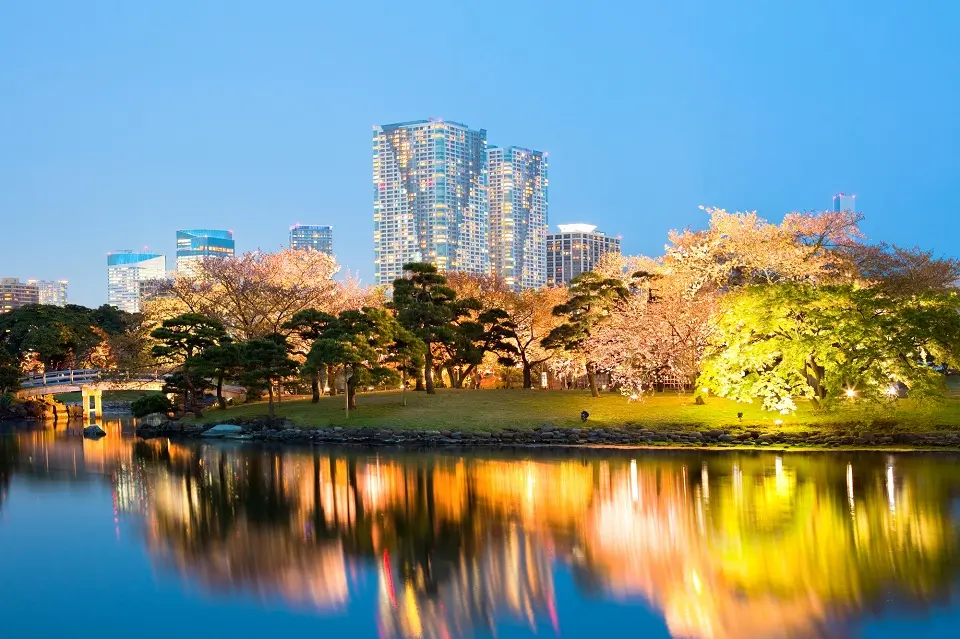
Hama-Rikyu Gardens (浜離宮恩賜庭園) is a large public park with picturesque landscaping alongside Tokyo Bay.
This historical site dates back to the 17th century when it was originally built by the royalties as their extended home in Tokyo. It was later used as a state guest house for foreign diplomats. It’s a large and picturesque garden that contrasts beautifully with the surrounding skyscrapers of the bustling city.
Hama-Rikyu Gardens is designated as a Special National Place of Scenic Beauty by the Japanese Cultural Affairs Agency.
Train Access to Hama-Rikyu Gardens
The Hama-Rikyu Gardens is 7 to 10 minutes walk from the following stations:
- From Shiodome Station by Toei Oedo Line (Exit E-19)
- Tsukiji-shijo Station by Toei Oedo Line (Exit E-18)
- From Yurikamome Shiodome Station by Yurikamome Line
- From Shimbashi Station by JR or Tokyo Metro Ginza Line/Toei Asakusa Line (Exit G-08 and A-10)
Features of Hama-Rikyu Gardens
The following is what you can expect when you visit Hama-Rikyu Gardens:
Landscaping:
Hama-Rikyu Gardens features a large saltwater central pond filled with Tokyo Bay saltwater, two ponds that were duck hunting sites in the past, an over 300-year-old pine tree, several plum and cherry blossom trees, and a beautiful field of rapeseed flowers.
While the water in the central pond changes with the tides in Tokyo Bay, the garden scenery changes with the seasons. You can witness different scenes in different seasons, with cherry blossoms in spring, the cosmos in autumn, and migratory birds in winter, giving this garden a different feel throughout the year.
Tea House:
Nakajima-no-Ochaya teahouse is on an artificial island in the park’s large pond. This wooden teahouse is reachable from the land by a wooden bridge. Here, you can relax with traditional Japanese tea while enjoying the view of the park.
Boat Ride to Asakusa:
Earlier in this article, we mentioned boat cruises along the Sumida River. You can take a boat cruise from the pier in Hama-rikyu Garden to Asakusa.
The natural beauty and relaxing atmosphere of Hama-rikyu Gardens make it a great place to take a break from Tokyo’s fast-paced life without leaving the city. You can stroll along the walking paths, relax with a team in the teahouse, or simply take in the scenery, and you will love this place.
Explore Ueno Park and its Museums
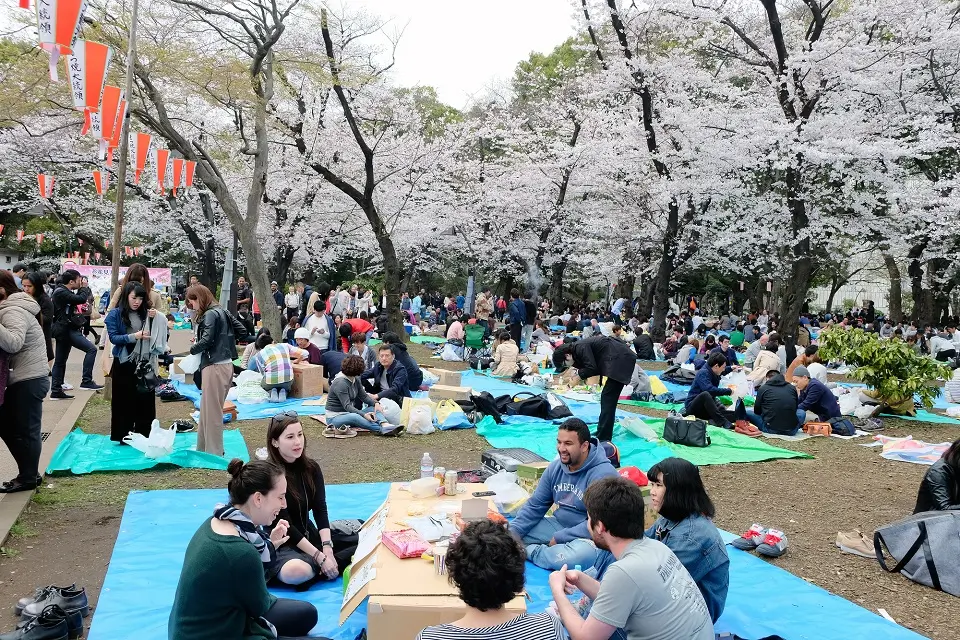
Located in the lively Ueno area in the Taitō ward (Taitō-ku), Ueno Park’s history dates back to 1873 as one of the oldest public parks in Japan.
This park is equally admired by foreign tourists and locals and possesses an interesting history. Ueno Park was established on the lands of the destroyed complex of a former major power center, Kaneiji temple.
Rather than just as a park, Ueno Park is famous for its museums, historical monuments, and the largest zoo in Tokyo, Ueno Zoo (Ueno Zoological Gardens / 恩賜上野動物園). Ueno Garden is also a very popular destination among Japanese for Hamami (flower-viewing) parties during the Sakura (cherry blossom) season.
Accessing Ueno Park
Ueno Park is a short walk from Ueno Station and Keiseiueno Station as follows:
- A 2-minute walk from Ueno station of JR by Tokyo Metro Ginza Line and Hibiya Line
- 1-minute walk from Keisei Ueno station of Keisei Line
Things to Do in Ueno Park
There are a lot of things you can do and see in Ueno Park. The following are some of the main attractions:
Museums in Ueno:
Ueno Park is sometimes called the “museum district” because it houses several of Tokyo’s most important museums. These museums include the following:
- Tokyo National Museum (the world’s largest collection of Japanese art)
- Ueno Royal Museum
- National Museum of Western Art
- National Science Museum
- Tokyo Metropolitan Art Museum
Ueno Zoo:
Ueno Zoo was established just 9 years after the establishment of Ueno Park, i.e., in 1982, and is Japan’s oldest and Tokyo’s largest zoo. It has over 3,000 inhabitants of over 500 species, including giant pandas from China, elephants from India and Thailand, tigers, gorillas, polar bears, and various birds.
A visit to the Ueno Zoo is not just about watching and learning about animals; the huge area has several small eating joints. Eating and relaxing while you explore the zoo is a picnic-like experience.
Shinobazu Pond:
Located in the southern part of Ueno Park, the Shinobazu Pond, or Shinobazu no Ike (不忍池) literally translates to “Unbearable Pond” in English. However, the translation of the name does not do justice to the beautiful landscaping it adds to the park.
Out of the three sections of this large natural pond, the lotus pond, boating pond, and marshy pond, the lotus pond section remains covered with beautiful lotus flowers during the summers. If you are interested in bird watching, this pond is a good place as you can find many birds around it.
Temples and Shrines in Ueno Park:
Ueno Park also has several temples and shrines. These include the following:
- Toshogu Shrine (constructed in 1627 and dedicated to the founder of the Tokugawa Shogunate)
- Kiyomizu Kannon Temple (built in 1631)
- Bentendo Temple (built during the kan’ei period (1624 to 1644) on an artificial island inside the Shinobazu Pond)
Events and Performances:
One popular summer event is the Ueno Summer Festival (Ueno Matsuri), a five-week event featuring various performances and parades.
Moreover, you can enjoy various events and performances throughout the year, including outdoor concerts. You can also find independent individual performers who perform in their chosen fields.
Statues and Monuments:
Ueno Park also has several statues and monuments. Some of the famous ones are the Statue of Takamori Saigo, one of the most influential samurai in Japanese history, and the Flame of Hiroshima and Nagasaki, a monument to the victims of the atomic bombings.
Map of Ueno Park
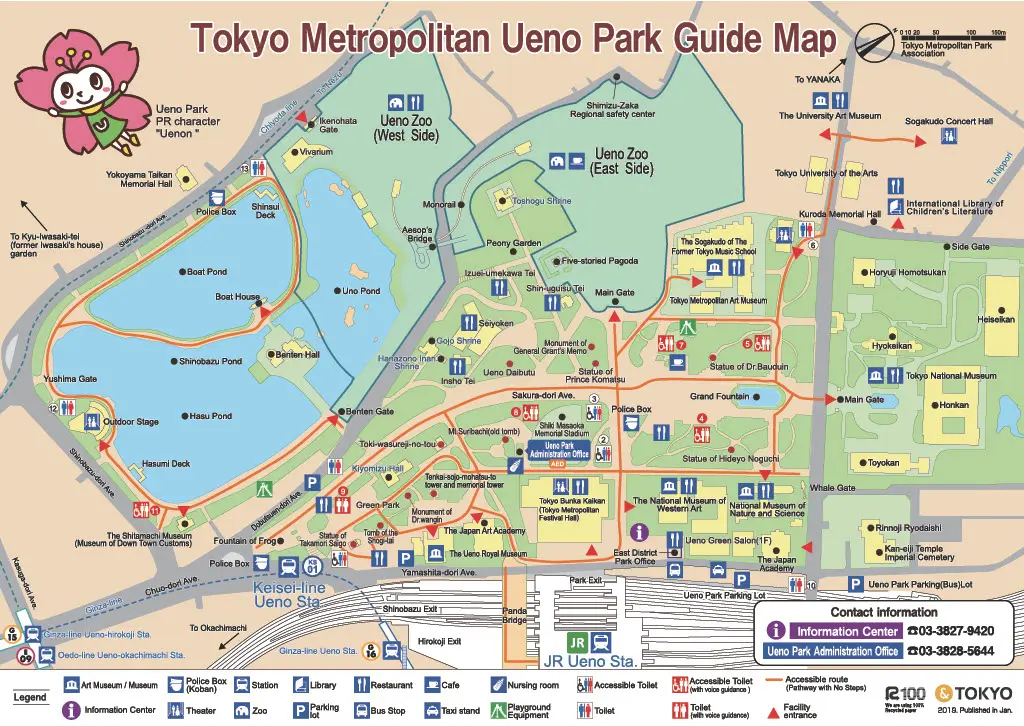
Omoide Yokocho (Memory Lane) in Shinjuku
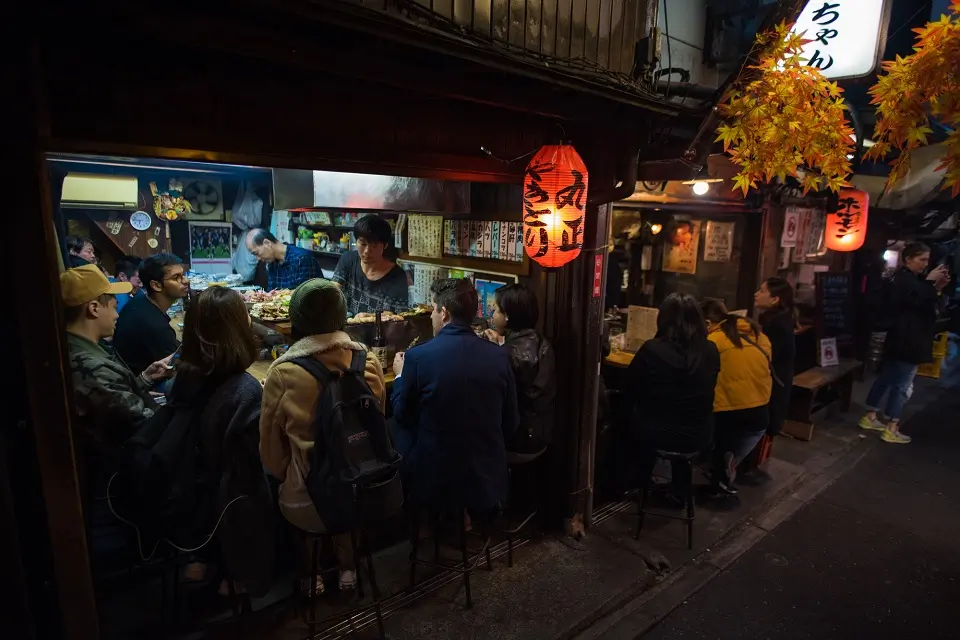
Omoide Yokocho is a bar district in Shinjuku that has a traditional atmosphere. Among its approximately 80 commercial establishments, there are around 60 bars and restaurants, including yakitori restaurants, and many restaurants with Motsu-yaki, or BBQ food from the internal organs of cows and pigs.
(Note: You may also like to read about the outdoor BBQ spots in Tokyo.)
Omoide Yokocho (Memory Lane) is also known as Piss Alley. It got its name as piss valley because, in the old days, there were no toilets in this area, and people had to relieve themselves outside. However, don’t worry; those days are long gone, and here, you can enjoy the atmosphere of Tokyo of the past post-war decades.
Many locals frequent the izakayas in Omoide Yokocho, making it a great place to interact with locals and experience the local nightlife.
Omoide Yokocho starts getting busy in the early evening, and it’s typically full by 7 or 8 pm, so consider going early if you want to avoid the crowds. Although many staff members in bars and restaurants might not speak English, you will find them friendly and welcoming to foreigners.
Access to Omoide Yokocho
A short walk from the following stations can access Omoide Yokocho:
- JR Shinjuku Station
- Odakyu Line Shinjuku Station
- Keio Line Shinjuku Station
- Seibu-Shinjuku Line Seibu-Shinjuku Station
- Tokyo Metro Marunouchi Line Shinjuku Station
- Toei OEdo Line Shinjuku Nishiguchi Station
Fish for Your Dinner at Zauo Shinjuku
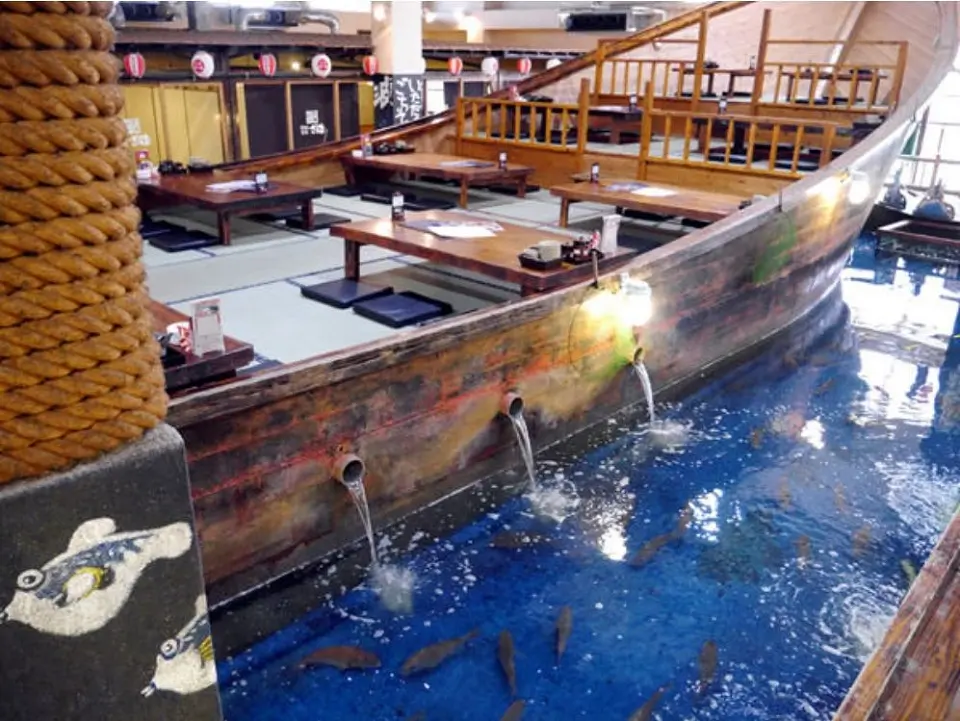
Not everyone gets a chance to go fishing, but many of us hope to experience the fun. If you are one of those and are also hungry, then Zauo Shinjuku is the place for you.
Zauo Shinjuku is a unique restaurant located in the Shinjuku Washington Hotel in the busy district of Shinjuku in Tokyo. Guests can fish for their own dinner. The name “Zauo” translates to “sit at the fishing place,” which is true to the restaurant’s theme.
Train Access to Zauo Shinjuku
The Zauo Shinjuku in Shinjuku Washington Hotel is conveniently accessible from the following stations:
- From Shinjuku Station: 8-minute walk
- From Tocho-mae Station: 5-minute walk
What Can You Expect at Zauo Shinjuku?
The Zauo restaurant has a large, boat-shaped seating area surrounded by a moat filled with different types of fish. These include sea bream, flounder, horse mackerel, and lobster. However, the availability of these types of fish may vary depending on the season.
In Zauo Shinjuku, you can buy bait and rent a fishing rod to catch fish to eat there. If you are new to fishing, you can ask the staff for help. When a customer successfully catches a fish, the staff joins them to celebrate by beating a drum and cheering, adding a fun and lively atmosphere to the dining experience.
After catching a fish, you can choose how you want it prepared, just like the regular menu items. However, if you don’t like to fish or fail to catch, you can order your food from the menu as you would in a normal restaurant. Moreover, just like any other large restaurant, their menu has various options other than seafood, including meat and vegetarian dishes, salads, and desserts.
Pricing at Zauo Shinjuku depends on the type of fish you catch. Each fish is individually priced, and the cooking fee depends on your chosen preparation method.
Zauo Shinjuku offers a unique, interactive dining experience that’s fun for all ages. Even if you are not interested in fishing and eating your catch, you can enjoy fresh seafood in a lively atmosphere.
If you plan to visit Zauo Shinjuku, it’s highly recommended that you make a reservation beforehand.
Visit Tokyo’s Themed Cafés
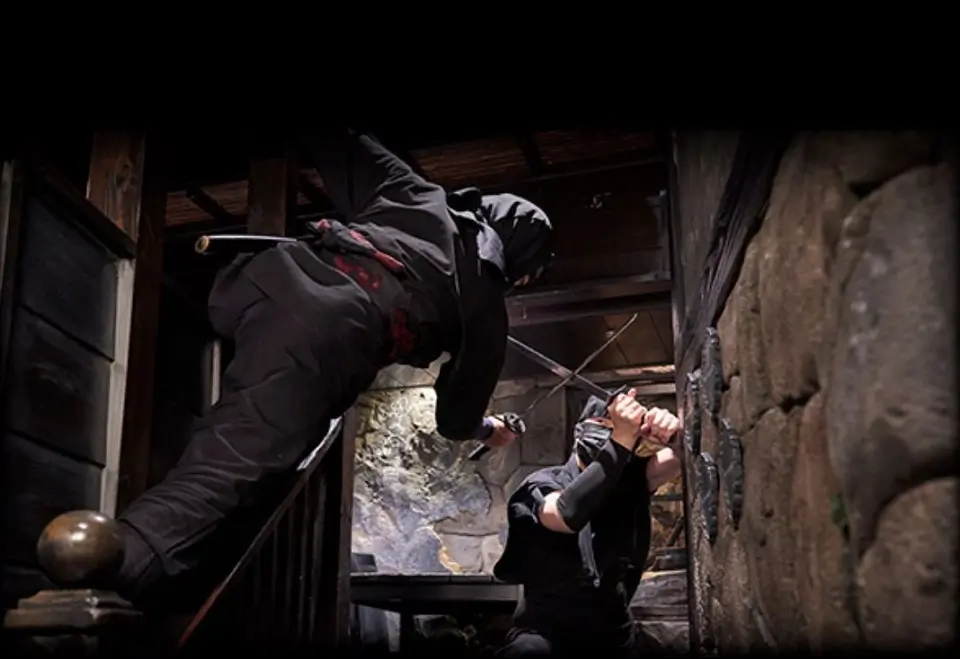
Tokyo is well-known for its wild and unique themed cafés. There’s a themed café for almost every interest, from cats to maids to robots. Here are some particularly famous or unique ones you might want to include:
Owl Cafés:
At an owl café, you can enjoy a drink with real owls. There are two popular owl cafés in Tokyo: “Owl Café & Bar Owl Village” in Harajuku and Owl Café in Akihabara.
Vampire Café:
Vampire Café is a Gothic-themed café in Ginza that offers a dining experience straight out of a vampire movie. It may not be the best place to take small kids; however, if you love horror movies, you might enjoy the Café’s blood-red, dimly lit decor, a human skull here or there, and waiters dressed as vampires.
Ninja Tokyo (Formerly Nija Akasaka):
This ninja-themed restaurant, “Ninja Akasaka,” was originally in Akasaka. It moved to Tokyo in December 2023 with a new name, “Ninja Tokyo.” This restaurant offers a unique dining experience in a ninja village. It is worth experiencing the maze-like hallways, ninja-style performances, and food served by staff dressed as ninjas.
Penguin Bar Ikebukuro:
You can enjoy your drink in Penguin Bar while watching real penguins frolic in a specially designed enclosure. However, I agree with Jasper Wilkins’ comments here.
Visit a Cat Café
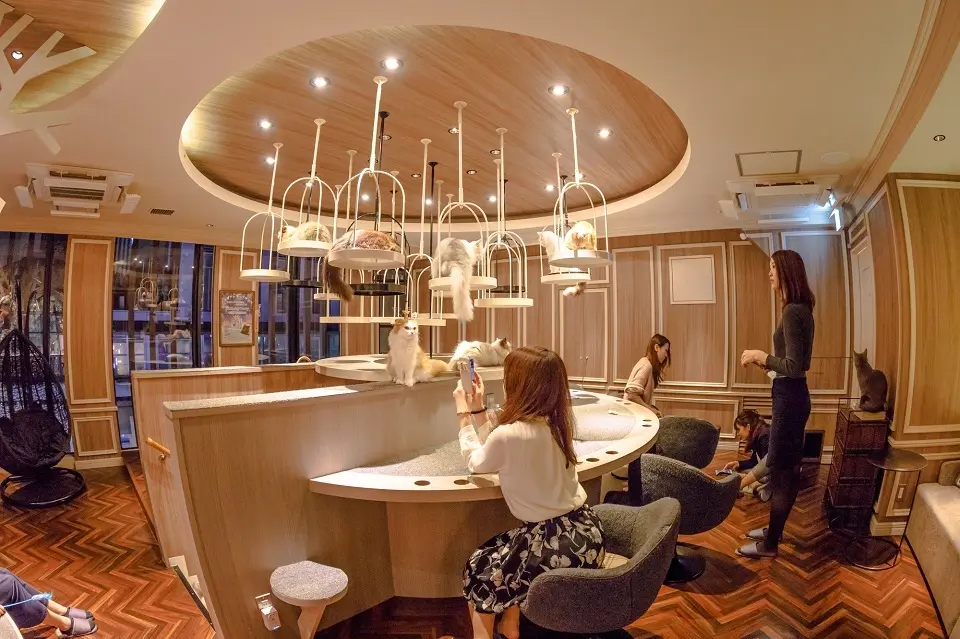
The Japanese obsession with cats was a natural magnet that instantly made cat cafés popular in Japan. This concept originated in Taiwan in the late 1990s.
Cat cafés allow customers to interact with cats while enjoying coffee or tea. This concept has been particularly embraced in cities like Tokyo, where many apartment buildings strictly prohibit pets.
Reputable cat cafés take the welfare of the cats seriously. The cats are usually well-cared for, and rules are typically in place to protect them, such as restrictions on picking them up, limits on the number of customers at any one time, and “quiet hours” for the cats to rest.
Unlike normal cafés, cat cafés charge you for the time spent there, i.e., hourly pricing. However, some cat cafés also have an advance cover charge, which may include unlimited non-alcoholic beverages.
As for specific cat cafés in Tokyo, there are several well-known ones:
Cat Café MoCHA:
Cat Café MoCHA is a large chain of cat cafés across Japan with a couple of overseas branches. Among its 32 branches in Japan, 10 are in the 23 wards of Tokyo, 3 in Saitama, and 1 in Chiba. Cat Café MoCHA is known for its comfortable, clean, stylish interior and many friendly cats across its various branches.
Calico Cat Café:
One of Tokyo’s most popular cat cafés, Calico Cat Café, was established in Shinjuku and has many cute cats of different breeds. The success of their Shinjuku café inspired them to expand the business by opening their second branch in Tokyo’s Kichijoji area in 2023.
Neko Maru Café:
Neko Maru Café in Ueno is praised for its calm atmosphere and the well-being of its cats. The holding company also runs a cat hotel, indicating the availability of staff experienced in caring for cats.
Temari no Ouchi:
Located in Kichijoji of Musashino city in the Tokyo Metropolis area, Temari no Ouchi Cat Café stands out because of its unique fairytale-like interior. It’s a bit more expensive than most other cat cafés, but it’s also one of the most Instagram-worthy.
Visiting these themed cafés offers more than just food and drinks – they offer unique experiences that can make your trip to Tokyo even more memorable.
Moreover, apart from cats and owls, Tokyo has cafés featuring a variety of animals like hedgehogs (Hedgehog Café Harry), rabbits, and reptiles (Tokyo Snake Center).
Edo-Tokyo Open Air Architectural Museum
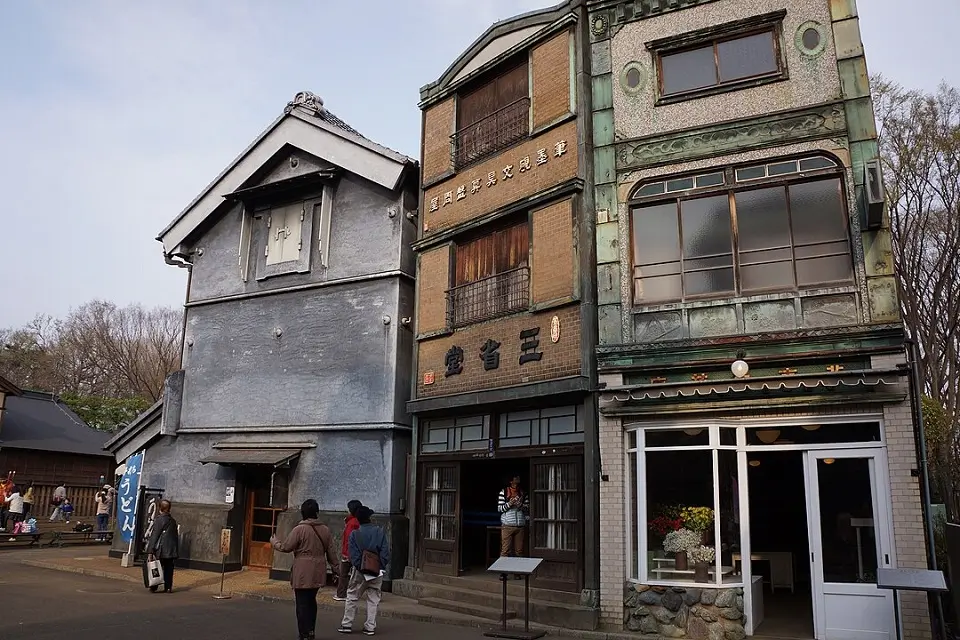
Are you a lover of historical architecture? Wouldn’t it be convenient and fun to see some of the great historical buildings as a group in one area instead of traveling from place to place?
If you agree with the above, you will appreciate this fascinating destination, Edo-Tokyo Open Air Architectural Museum, in Koganei Park just outside central Tokyo.
Access to Edo-Tokyo Open Air Architectural Museum
Edo-Tokyo Open Air Architectural Museum is easily accessible by trains and buses. Please check the museum’s official site to access it here.
More Details about the Museum
Historical Buildings:
It’s very easy for any government to preserve public buildings and structures. However, what if there are great buildings in private ownership that are worth preserving as historical landmarks?
As they say, there is a way if there is a will. The Tokyo Metropolitan government found the solution to the above problem by coming up with the Edo-Tokyo Open Air Architectural Museum.
The vast 7-hectare area of the Edo-Tokyo Open Air Architectural Museum is dedicated to relocating or reconstructing private buildings of historical value as a preservation measure. The reconstructed buildings are not original but are constructed as a copy of the original.
As of 2024, the Edo-Tokyo Open Air Architectural Museum exhibits 30 historical buildings from the Edo period (1603-1868) to the early Shōwa period (1926-1989). These buildings include various structures, including private houses, shops, a bathhouse, and a sake brewery. You can check the list of the buildings on the museum’s official site.
All the museum’s buildings are carefully preserved and restored to their original state. Most are furnished with period-appropriate items, giving visitors a true sense of what life was like during these eras.
A museum with 30 buildings may no longer interest locals after they have seen it a couple of times. However, the Edo-Tokyo Open Air Architectural Museum keeps its relevance alive by holding many temporary exhibitions annually in addition to the permanent exhibits. The themes and dates of these exhibitions are posted on its official website.
Famous Exhibits:
One of the most famous buildings is the house of Hachirouemon Mitsui, a wealthy businessman during the Taisho era. Its impressive size and intricate design showcase the luxurious lifestyle of the upper class during that period.
Another popular structure is the house of Korekiyo Takahashi, a notable politician from the Meiji and Showa eras.
Workshops and Demonstrations:
Edo-Tokyo Open Air Architectural Museum occasionally hosts traditional craft workshops and other cultural events.
Visit Planning:
Edo-Tokyo Open Air Architectural Museum is closed on Mondays (or the following day if Monday is a holiday), so plan your visit accordingly. The buildings are spread out over a large area, so be prepared for a lot of walking.
Takeshita Street in Harajuku
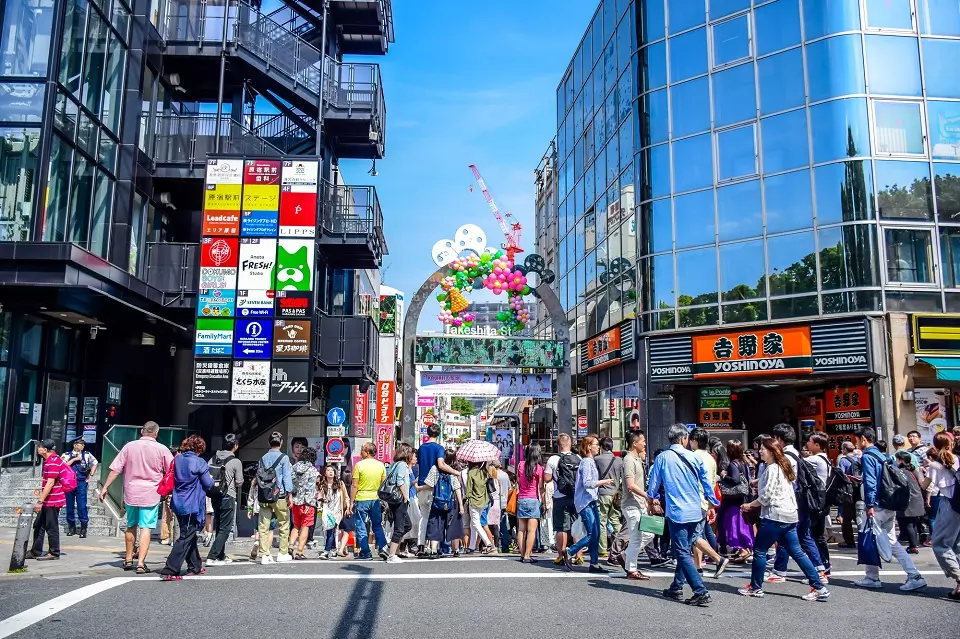
Takeshita Fashion Street in the Harajuku district of Tokyo is a pedestrian shopping street lined with fashion boutiques, cafés, and restaurants. The shops mainly cater to young people who seek unconventional or quirky fashion or follow Japanese pop cultures like Otaku and Kawaii.
Even if you do not fit into any of the above-mentioned categories, Harajuku, especially Takeshita Fashion Street, is worth visiting for its lively and vibrant atmosphere. There is always an exciting energy in the atmosphere, a unique experience only this place can offer.
Access to Takeshita Street
Takeshita Street in Harajuku is accessible by a short walk from the following two stations:
- JR Harajuku Station by Yamanote line
- Tokyo Metro Meiji-Jingumae Station by Chiyoda Line or Fukutoshin Line
Here are some notable things about Takeshita Street:
Quirky and Not So Quirky Fashion Shops:
Takeshita Street is famous for its diverse and quirky clothing and accessories stores. They range from vintage shops to trendy boutiques specializing in various styles such as gothic lolita, visual kei, and cosplay costumes.
Moreover, shops like Daiso, Japan’s famous 100-yen store, and WEGO, a popular local clothing brand mainly targeting teenagers, have their flagship stores here.
Cafés and Sweet Treats:
The street is also famous for its stores and restaurants serving unique and creative food. You’ll find a wide range of Japanese sweets like the colorful “Harajuku crepes,” huge fairy floss from Totti Candy Factory, and the unique Zaku Zaku and Calbee Plus desserts. Moreover, there are also many themed cafés, like the Kawaii Monster Café and animal cafés.
Purikura Photo Booths:
The word Purikura combines “Print” and “Club.” Puri comes from the Japanese pronunciation of the word print (“purinto” in Japanese), and kura comes from the Japanese pronunciation of club, which is “kurabu”.
A Purikura is a Japanese photo booth (equally famous in S. Korea also) where you can take digital pictures and decorate them with a wide range of cute and funny effects. These booths are popular among Japanese teenagers and can be a fun activity to try while on Takeshita Street.
Ura-Harajuku:
If you wish to have a more sophisticated and less crowded shopping experience, you should try the backstreets of Ura-Harajuku. Here, you’ll find more upscale boutiques, design studios, and upscale cafés.
Every place in Tokyo offers something unique. It’s like seeing and witnessing different colors, and it’s always good to see and experience as many of them as possible in this city. That is the only way to know Tokyo in its entirety.
Walking down Takeshita Street is another unique experience, another color in the rainbow of Tokyo that you should not miss. Its energy, quirky fashion, and pop culture make it one of the city’s most exciting and distinctive places.
Tsukishima Monja Street to Enjoy Monjayaki
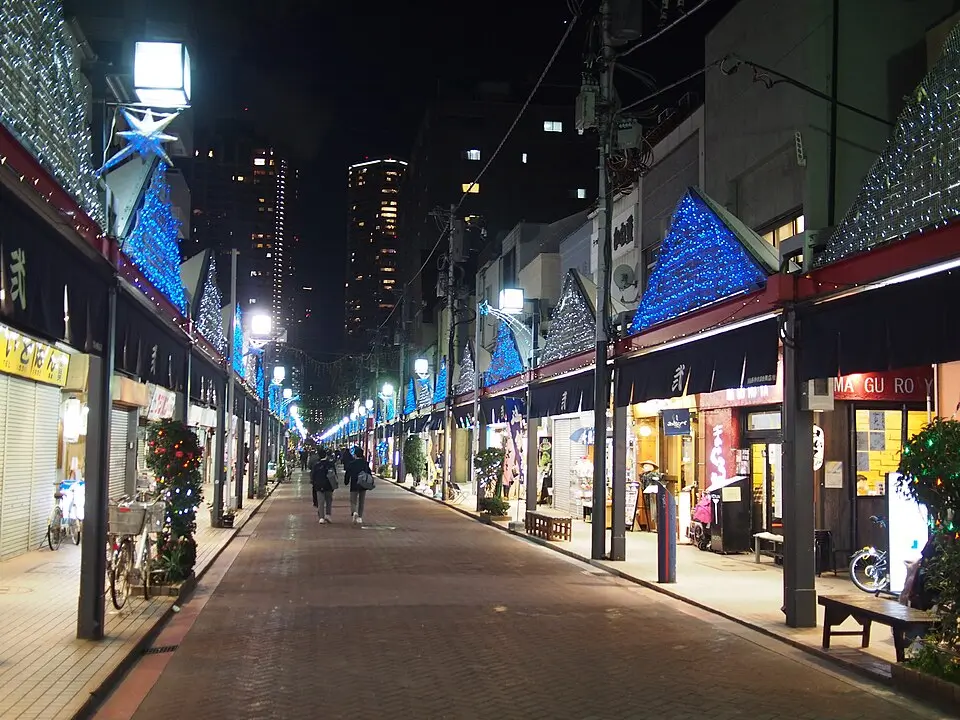
Tsukishima Monja Street, often called “Monja Street,” is in Tsukishima, an artificial island in Tokyo’s Chūō ward, or Chūō-Ku. Tourists often overlook this place, but it is a favorite among locals.
The main attraction here is Monja Street—a charming lane packed with more than 70 small eateries specializing in monjayaki.
Access to Tsukishima Monja Street
The Tsukishima Monja Street is a 1-minute walk from the Tsukishima station. You can reach Tsukishima Stations by the following two train lines:
- Tokyo Metro Yurakucho Line
- Metropolitan Subway Oedo Line
Things to Experience in Tokyo’s Tsukishima Monja Street
Some of the main details to plan your visit and activities at Tsukishima Monja Street are as follows:
Monjayaki:
Monjayaki, often affectionately called “Monja,” is a traditional Tokyo dish similar to Okonomiyaki. It’s a runny pancake with various ingredients like meat, seafood, vegetables, and a special savory sauce. It might not be the most photogenic dish, but it’s delicious and is considered a must-try food experience in Tokyo.
The Tsukishima Monja Street has nearly 80 restaurants where you can enjoy Monjayaki.
Cooking Experience:
Eating Monjayaki is more than just eating; rather, it’s cooking and eating. When you order Monjayaki, it’s cooked at your table on a hot iron grill. Part of the fun is participating in the cooking process. Restaurant staff will often demonstrate how to cook the first one, and then you can cook subsequent ones yourself.
Variety of Eateries:
Monja Street offers a variety of places to try this dish. Each restaurant has its own recipe and unique ingredients. So, if you are hungry enough, it’s worth trying more than one place, especially if you stay in the area longer.
Some of the well-known eateries on Monja Street include “Monja Kura,” “Monja Mugi,” and “Tsukishima Monjayaki Shinchan.”
Tsukudani Shops:
Tsukishima is also known for Tsukudani, a preserved food simmered in soy sauce and mirin. While in the area, you can not only try this dish but also have an opportunity to peek into the past through many small Tsukudani shops that have been in this area for generations.
Nishinaka Street:
Nishinaka Street is a smaller alley off Monja Street filled with tiny, old-fashioned bars and eateries. It’s a popular place to go for drinks and enjoy those in a traditional atmosphere among the locals.
Tsukishima Community Center:
If you’re curious to know more about the area’s history, the Tsukishima Community Center has a small museum with exhibits about the history and culture of Tsukishima. However, this is just information and not a recommendation because a visit there may not be worthwhile if you do not understand Japanese.
Tsukishima and Monja Street, in particular, are charming areas that can make you feel like you are looking back in time and provide a wonderful break. It’s definitely worth a visit if you’re interested in trying authentic local cuisine.
Explore the Craft Beer Scene

Lately, Tokyo has seen a rapidly growing craft beer scene, with microbreweries and craft beer pubs all over the city. Whether you’re a casual beer lover or love craft beers, Tokyo has many places to experience. Here are some key places and events you might want to include on your bucket list:
Mikkeller Tokyo:
Mikkeller Bar Tokyo is an extension of the Danish craft brewing company Mikkeller in Shibuya. It offers an extensive selection of beers on tap, including Mikkeller Breweries’ own brews and a range of guest beers from around the world.
Hitachino Brewing Lab:
Located near Akihabara Station, the “Hitachino Brewing Lab” brewery by the famous Kiuchi Brewery (creators of Hitachino Nest Beer) is a must-visit. Here, you can enjoy a wide variety of craft beers and even some exclusive brews that are only available at this location.
Craft Beer Market:
With several locations around Tokyo, including Jimbocho and Toranomon, the Craft Beer Market offers a rotating selection of Japanese and international craft beers at very reasonable prices. The lively atmosphere and food menu make it a popular spot.
Spring Valley Brewery:
If you are not new to Japanese beer, you will know Kirin, one of Japan’s major beer manufacturers. What most of you might not know is that Kirin has a subsidiary known as Spring Valley Brewery in the Daikanyama district of Tokyo.
Spring Valley Brewery offers a variety of craft-style beers brewed on-site. The spacious, modern brewery also has a restaurant serving food that pairs well with its beers.
Antenna America:
If you are into American beers or wish to explore those, Antenna America is a good option.
Antenna America’s Tokyo branches are in Yaesu, Chuo-ku, and Shinagawa. They also have branches in Yokohama, Minamisaiwai, and Yoshida-cho, Naka-ku. It’s a great spot to try various imported American beers with American fast food.
Beer Festivals:
Tokyo hosts several craft beer festivals throughout the year. One of the popular beer festivals is the Great Japan Beer Festival.
This beer festival, hosted by the Craft Beer Association of Japan, takes place in the summer. During this festival, you can experience hundreds of craft beers from across Japan. Another popular event is the Tokyo Craft Beer Week, where many craft breweries from Japan participate.
Sushi-Making Classes in Tokyo
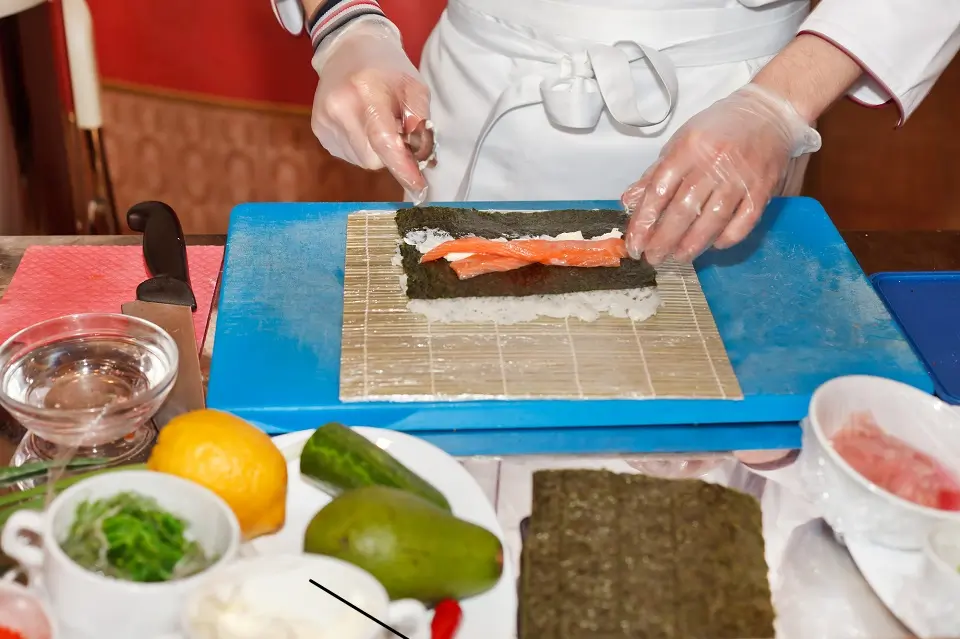
Sushi is, without a doubt, Japan’s signature dish. Who can think about Japan without it? While eating this Japanese delicacy can be fun in Tokyo, taking a sushi-making class is a great way to experience Japanese food culture.
Here are some recommended places in Tokyo where you can take a sushi-making class:
Tokyo Sushi Academy:
With various options according to students’ level of knowledge, i.e., beginners to intermediate or even higher, the Tokyo Sushi Academy is quite famous for learning sushi making.
No Japanese? No problems.
Of course, as a foreigner, you might be looking to learn sushi preparation as a beginner. And here’s what you might be looking forward to—a 90-minute beginner’s sushi-making class in English offered by the Tokyo Sushi Academy in Shinjuku.
Chagohan Tokyo:
Chagohan Tokyo, located in Kappabashi Kitchen town in Asakusa, is another foreigner-friendly cooking school that offers English lessons. Though sushi-making classes are a focus area, they offer cooking classes for other Japanese dishes, including okonomiyaki, tempura, gyoza, soba noodles, and more.
Preparing a delicacy like sushi is not just about knowing how to make it; it is equally crucial to know how to select what to buy. Considering this important aspect, Chagohan, Tokyo’s sushi-making lessons involve a trip to a local market to buy fresh ingredients.
Mayuko’s Little Kitchen:
Run by a Japanese home chef, Mayuko’s Little Kitchen in Shibuya offers a homestyle cooking experience. Mayuko’s sushi class includes making sushi, miso soup, and matcha green tea.
YUCa’s Japanese Cooking:
The founder of YUCa’s Japanese Cooking, or YJC, comes from an interesting background of growing up in a farming family and then moving to Canada and the USA as a food writer before founding YJC in the residential neighborhood of Nakano.
Similar to most other cooking classes in Japan, YUCa’s lessons cover various Japanese dishes, including sushi. While she conducts in-person classes for small groups or even private lessons for individuals or private groups, you can also access virtual (online) classes.
AirKitchen:
AirKitchen is an interesting platform to connect locals interested in providing cooking lessons to learners. Being a platform on AirKitchen, you can find cooking classes all over Japan and not just in Tokyo. Apart from the in-person cooking lessons, they also offer online classes.
Daikanyama: Experience Modern but Quiet Tokyo
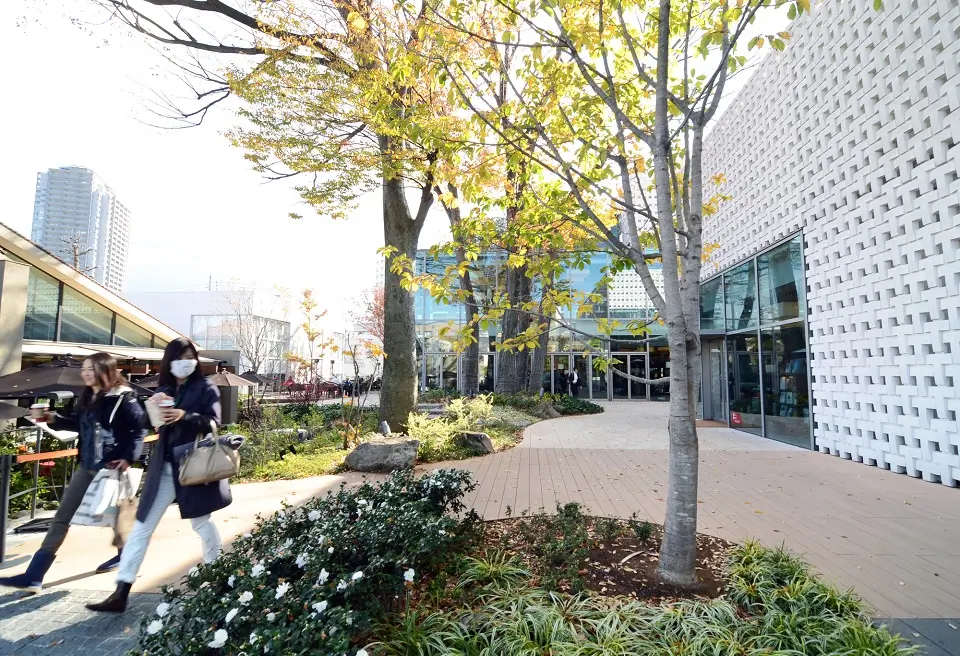
There are many ultramodern and trendy areas in Tokyo. However, if you wish to be in a trendy area that is cozy and relaxing and where you do not need a specific objective to visit other than to stroll, sit, or relax while admiring the trendy atmosphere, Daikanyama is for you.
Daikanyama is a stylish, quieter neighborhood located a short walk from Shibuya. It’s well-known for its boutique shopping, upscale residences, trendy cafés, and modern architecture.
Access to Daikanyama
The following are the options to reach Daikanyama:
- Tokyu-Toyoko Line to Daikan-Yama Station
- A 15-minute walk from Shibuya Station
- A 10-minute walk from Ebisu Station
Things to Do in Daikanyama
The following are the main things that you should not miss while you are in Daikanyama:
Architecture:
If you appreciate modern architecture, you will love to walk around Daikanyama and see some great modern structures. One of the popular structures in Daikanyama is the Hillside Terrace, designed by famed Japanese architect Fumihiko Maki.
Cafés and Restaurants:
Daikanyama has a fantastic selection of cafés and restaurants, from trendy coffee shops to top-notch restaurants. Ivy Place is a particularly popular café, and the neighborhood also boasts several French-inspired bakeries and patisseries.
Daikanyama Log Road:
Daikanyama Log Road is a pedestrian-only retail strip that used to be a train line. It now has unique boutiques, eateries, and even a craft beer brewery.
Kyū Asakura House:
Kyū Asakura House is a preserved early 20th-century private residence with a large garden that’s open to the public. A visit to the Kyū Asakura House allows feeling the elegant lifestyle of Tokyo’s upper class during the Taishō period (1912–1926).
Daikanyama is the perfect place for a relaxed, upscale Tokyo experience. Its unique blend of modern trends and laid-back charm makes it an excellent place for a leisurely day exploring the quieter side of Tokyo’s urban culture.
Can We Ignore the Most Famous Places and Activities?
This guide covered many places and activities that may be off Tokyo guidebooks and are relatively less known. However, a tourist guide is never complete if we do not mention the famous places and activities that you may already know about but may not know some details. So, let’s have a look at the following most famous tourist places in Tokyo:
Tokyo Disneyland
Out of the 6 Disneylands in the world, one is Tokyo Disneyland. However, some facts about Tokyo Disneyland are not commonly known. These are as follows:
- Tokyo Disneyland was established on April 15, 1983, as the first Disneyland outside the U.S.A.
- Tokyo Disneyland is the only Disneyland in the world that is not owned and operated by the Walt Disney Company. This Disney Park was established by Oriental Land Company, Limited, a Japanese company, and is 100% owned and operated by them. They pay a licensing fee to the Walt Disney Group.
- Tokyo Disneyland is actually NOT inside Tokyo City. Yes, it is in Chiba prefecture, adjacent to Tokyo. However, Chiba falls under the Tokyo Metropolitan Area, so calling it Tokyo Disneyland is not wrong.
Tokyo DisneySea
There are 12 Disney Parks worldwide and 6 Disneyland resorts. However, there is only one DisneySea globally, and that is Tokyo DisneySea.
Tokyo DisneySea contrasts sharply with Disneyland in looks and feel. While Disneyland is designed to look classically stylish and shiny to do justice to various characters, DisneySea is designed to look like a rusty old Mediterranean coastal town.
As the name suggests, most DisneySea attractions have water or the ocean as their theme. However, many popular attractions do not relate to water, e.g., “Soaring: Fantastic Flight,” “Tower of Terror,” etc.
Attractions-wise, Tokyo DisneySea’s rides are more adventurous than Disneyland’s, making it more popular among adults than kids.
Tokyo Tower
Tokyo Tower was built in 1958 and was the tallest structure in Japan until 2010 when Tokyo Skytree came into existence. This 332.9-meter-tall communication tower was inspired by the Eiffel Tower in its design but beat the Eiffel Tower in height by 2.9 meters.
Tokyo Tower is a popular destination for tourists and locals because of its two observation decks, which are 150 meters in height and 249.6 meters in height. The 360-degree views of Tokyo offered by these observation decks are priceless.
Tokyo Skytree
Tokyo SkyTree was built in 2010 and reached its current height of 634 meters in 2011, claiming the title of the tallest tower and the third tallest structure in the world, after Burj Khalifa of Dubai (829.8 m) and Merdeka in Kuala Lumpur, Malaysia (678.9 m).
Like Tokyo Tower, the Tokyo Skytree is a broadcasting Tower with observation decks for visitors. Visitors can enjoy 360-degree views of Tokyo from 350 m, and 450 m, much greater heights than Tokyo Tower’s observation decks, which are 150 and 249.6 meters.
Asakusa Temple (Senso-ji)
Asakusa Temple, or Senso-ji, is undoubtedly one of the most popular destinations for foreigners and locals alike.
Though Sensoji was designated a temple in 1590, its history goes back to 628. You can read about its interesting history here. It is certainly not a place to miss when you visit Tokyo.
Meiji Jingu Shrine
Can you imagine a shrine with a forested land area of 70 hectares (170 acres, or 687966 square meters) right in the heart of Tokyo? It is difficult to imagine, but it is there—the Meiji Jingu Shinto Shrine, the largest shrine in Tokyo.
Meiji Jingu Shrine is a Shinto Shrine; visiting it and being there is much more than just experiencing a shrine. The vastness of it, the feeling that you are in a forest right in the middle of Tokyo, is surreal.
You can learn more about Meiji Jingu Shrine here. You can also check out various Shinto rituals at the Meiji Jingu Shrine here.
How Many Days for the First Visit to Tokyo as a Tourist?
One of the biggest challenges for anyone traveling to a foreign country for the first time is scheduling. With so many tourist places and things to do in Tokyo, you may also wonder how many days you must plan for your first visit to Tokyo.
For the first timers, 4 days is the minimum duration for the Tokyo visit. However, a stay of about 5 to 7 days in Tokyo is generally optimal. However, scheduling your Tokyo trip will typically depend on the following factors:
- Availability of time and budget
- Are you coming with family, including kids
- Is Tokyo the only destination, or if you are planning to visit other cities in Japan
- Places and activities meeting your specific interests
Based on the above factors, if you can afford more time, you can even spend 10 days in Tokyo to visit the best spots and to get to know the city better.
Minor Points but Helpful Things to Know
- From any one place to another place, you can reach within one hour inside Tokyo, and often some of the surrounding areas.
- The average time taken by Tokyo Metro from one station to the next is 2 minutes.
- JR and Tokyo Metro are two options connecting various areas in Tokyo. Tokyo Metro’s coverage is much higher than the JR’s, but cost-wise, the JR is cheaper than the Metro.
- The Tozai line is the most crowded metro train line during peak hours, i.e., mornings and evenings. This information can be handy for planning where to stay in Tokyo, depending on the places you wish to visit.
- The busiest JR line in Tokyo is the Yamanote line. For all practical purposes, you will use it, as it is the only loop line covering major areas in Tokyo.
- The bullet train, known as the Shinkansen, has three stations in Tokyo: Tokyo, Shinagawa, and Ueno. Tokyo and Shinagawa. From Tokyo station, you can take all Shinkansen operating from Tokyo. However, from Shinagawa, you can only take a bullet train (Shinkansen) to the south-west, towards Osaka, Nagoya, Kyoto, Fukuoka, and Hiroshima. From Ueno, you can take the Shinkansen to the northern side of Japan, i.e., towards Karuizawa, Nagano, Kanazawa, and Sendai.
Takeaways: Tokyo, Temples to Skyscrapers
We hope this guide will be your roadmap when looking for things to do in Tokyo.
The beauty of Tokyo lies in its contrasts and the great combination of ultramodernity while still keeping the air of traditional Japan in many places. It is a city where neon-lit skyscrapers and anime shops coexist with ancient temples and beautiful gardens.
Remember, the journey is not about the destination or specific places but everything we do along the way. Tokyo offers us endless things to do and not just specific spots to visit.
You may also like to check out Tokyo’s best outdoor barbecue spots. Moreover, if you plan to travel to other places in Japan apart from Tokyo, you may also like to know about some of the lesser-known but great tourist places in Japan. For hiking and climbing enthusiasts, we also have a guide for hiking in Japan featuring some of the best places for outdoor activities near Tokyo and across Japan.

A long-term ex-pat in Japan, Himanshu comes with an IT background in SAP consulting, IT Business Development, and then running the country operations of an IT consulting multinational. Himanshu is the co-founder and Managing Director of ReachExt K.K. and EJable.com. He is also an Advisory Board Member of a Silicon Valley AI/IoT startup.
